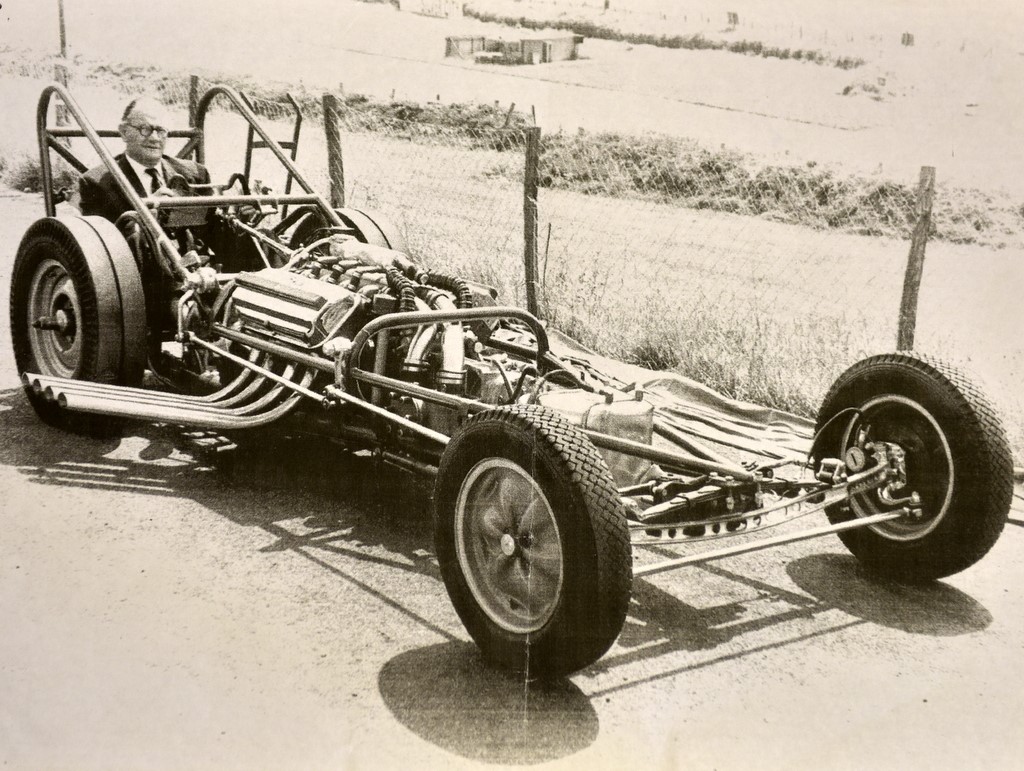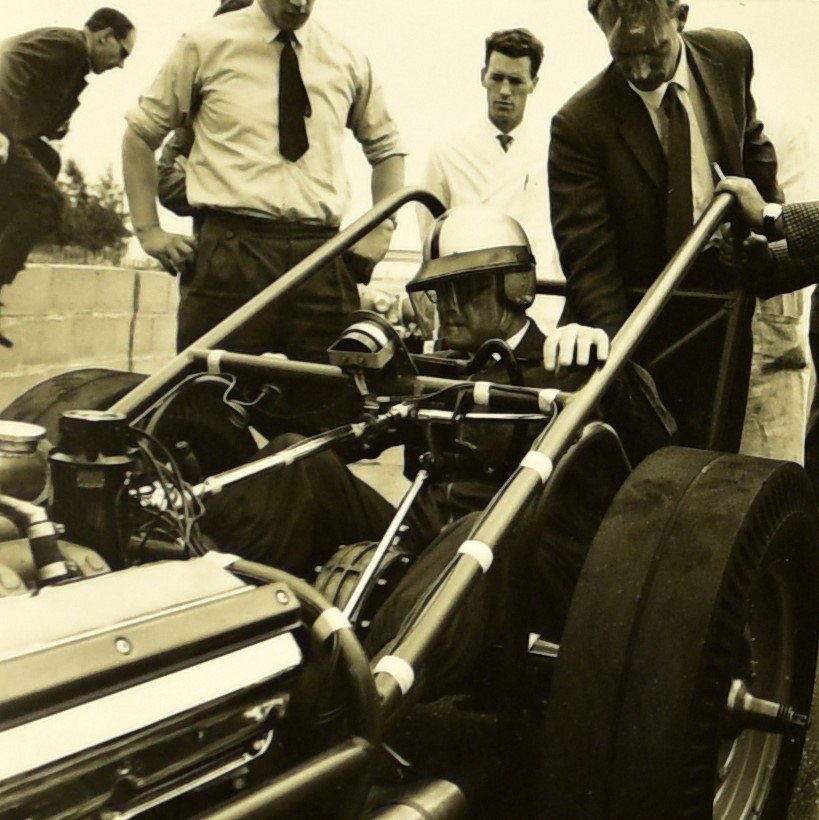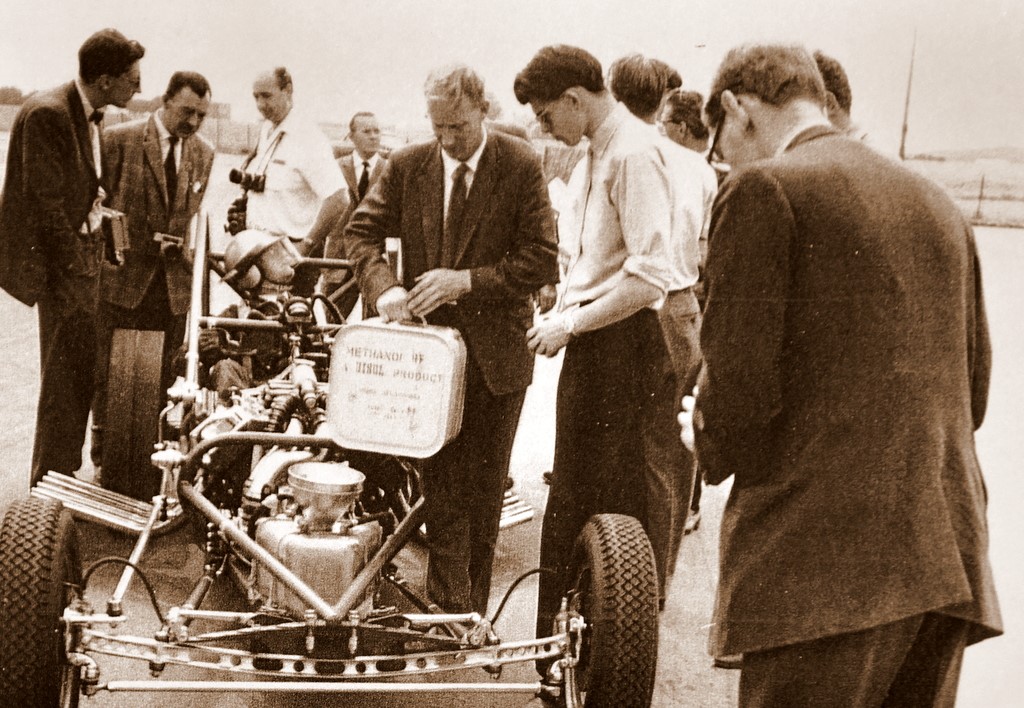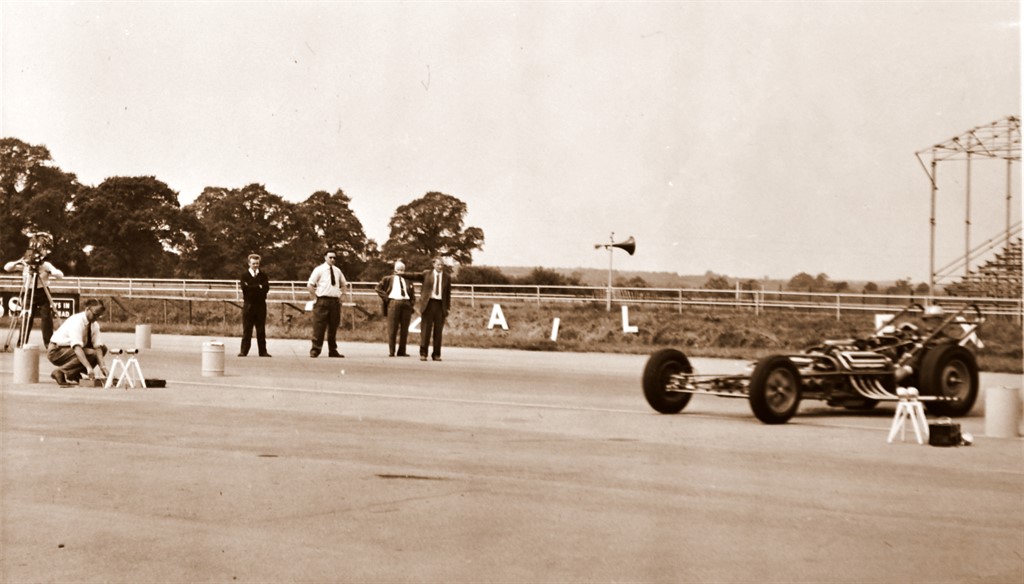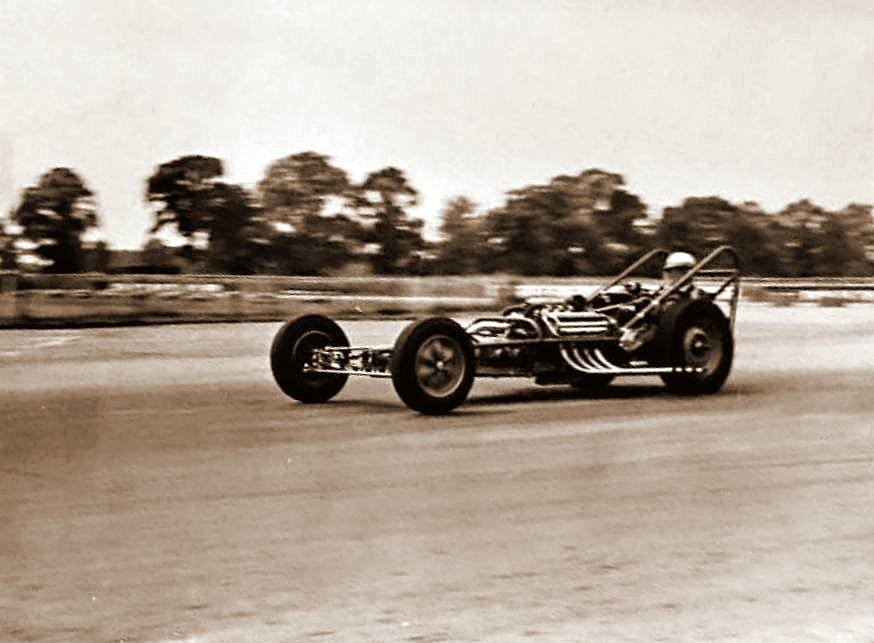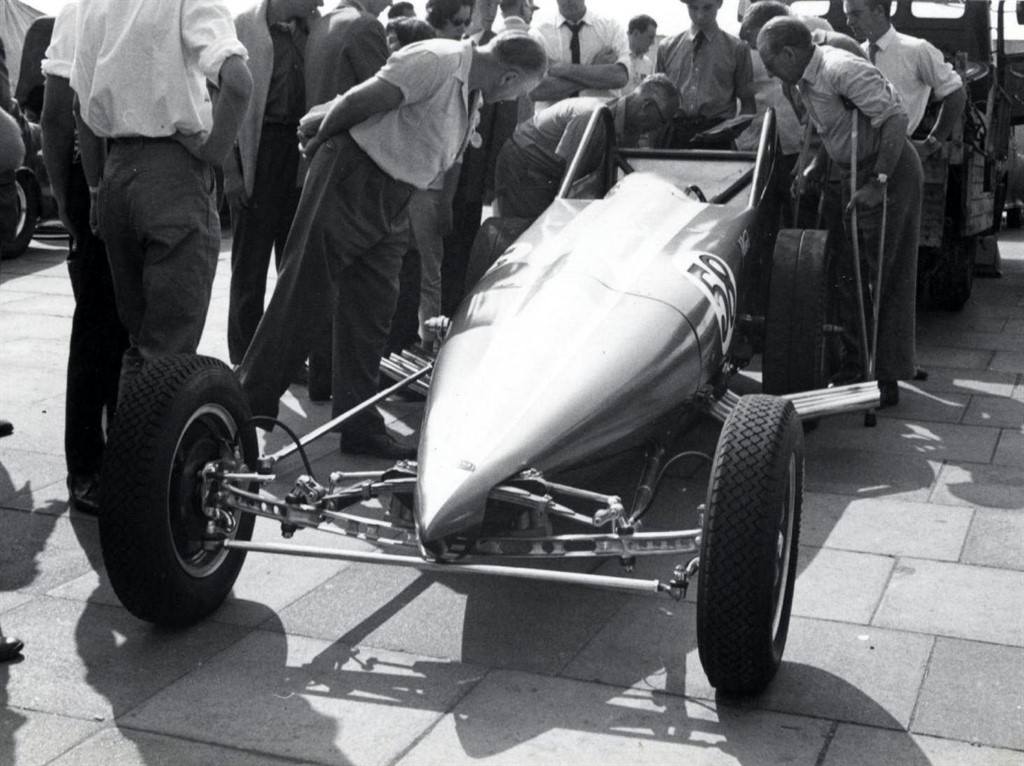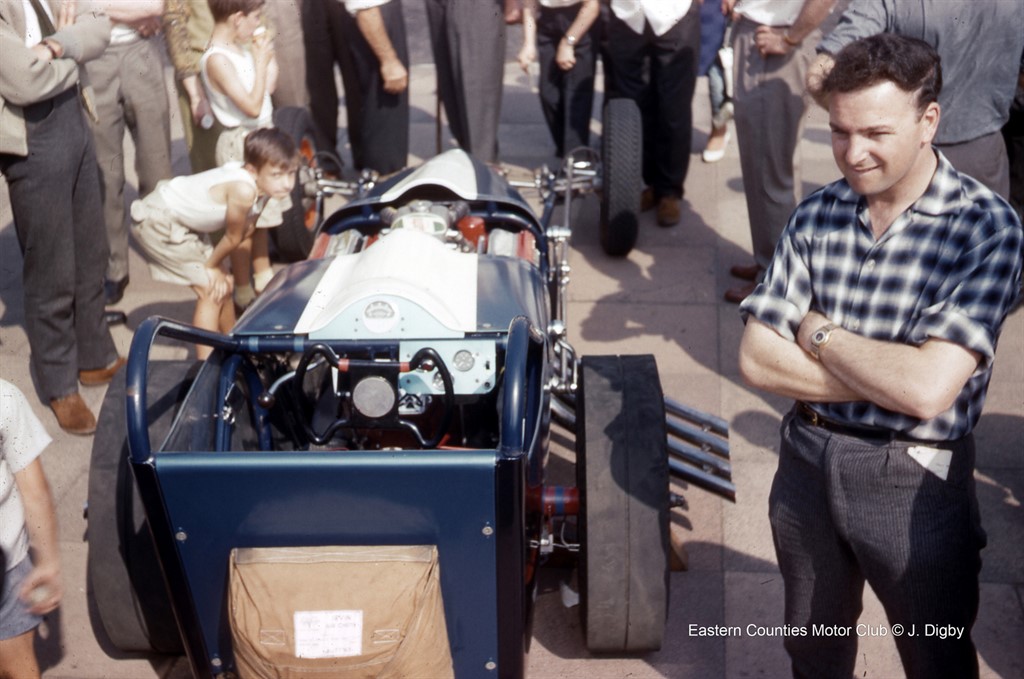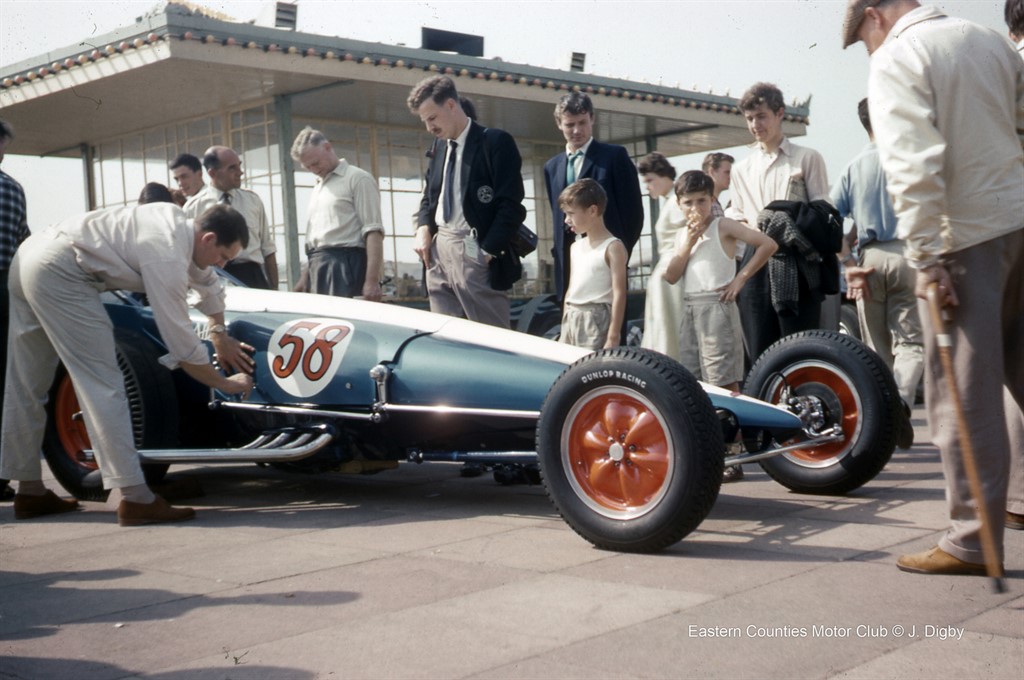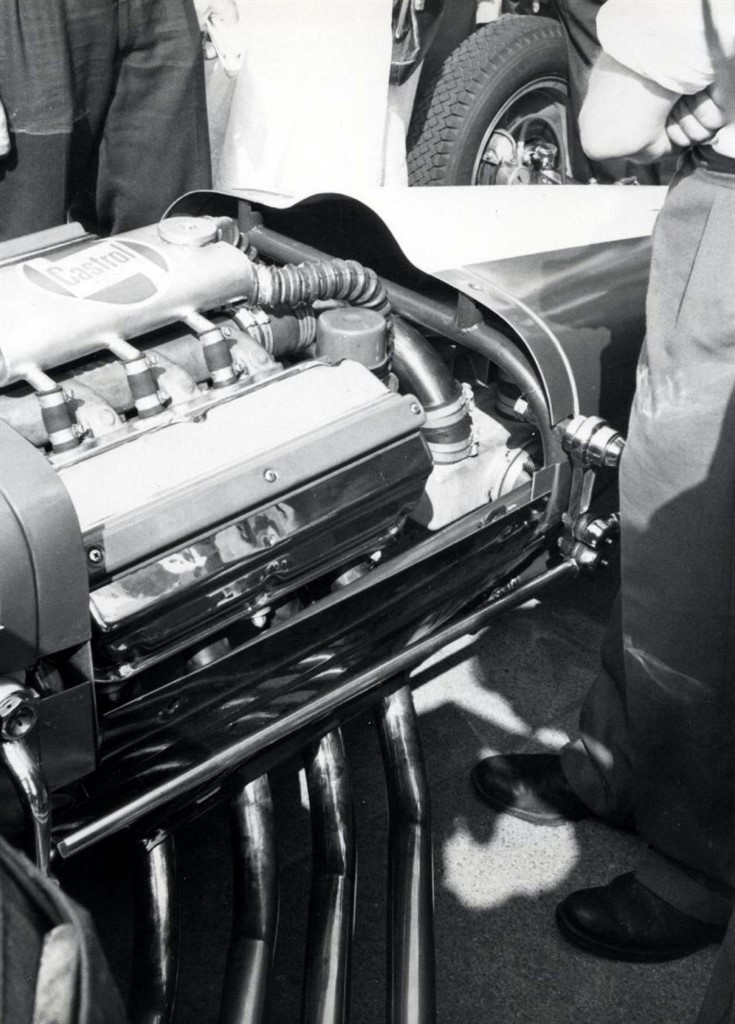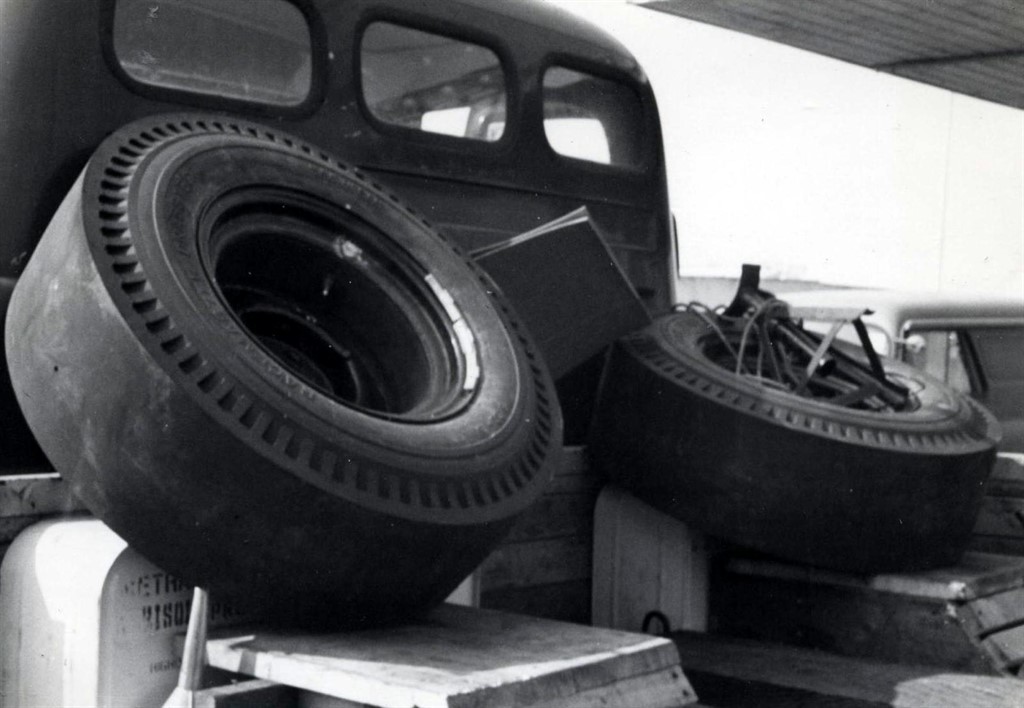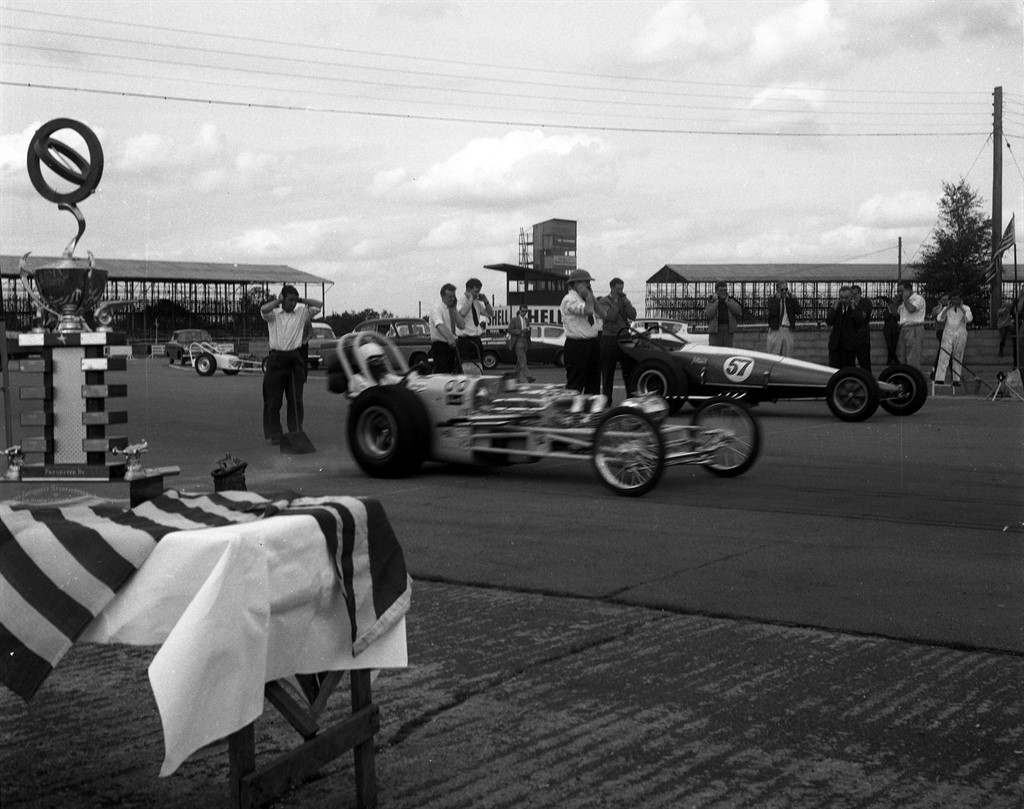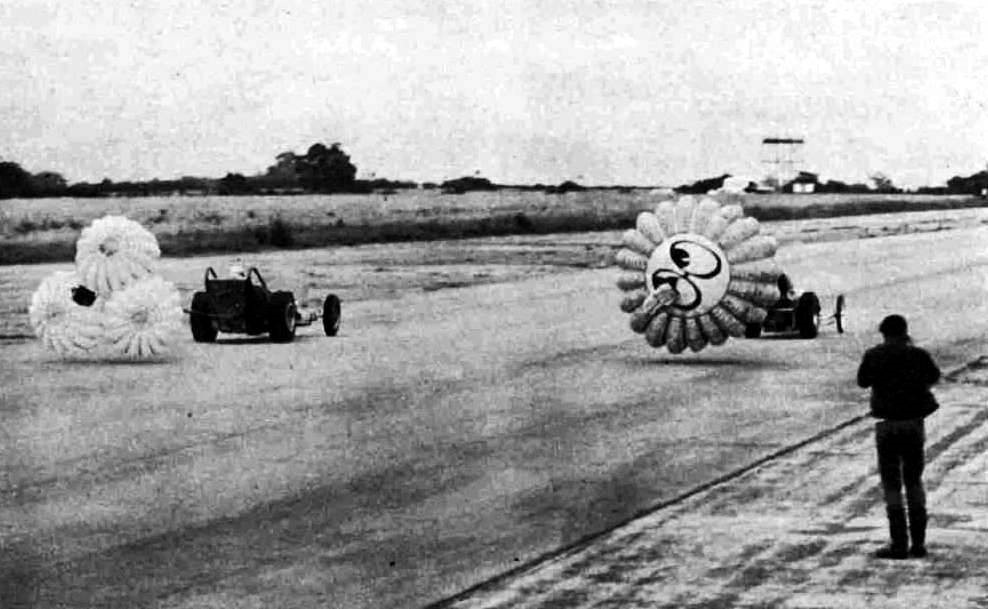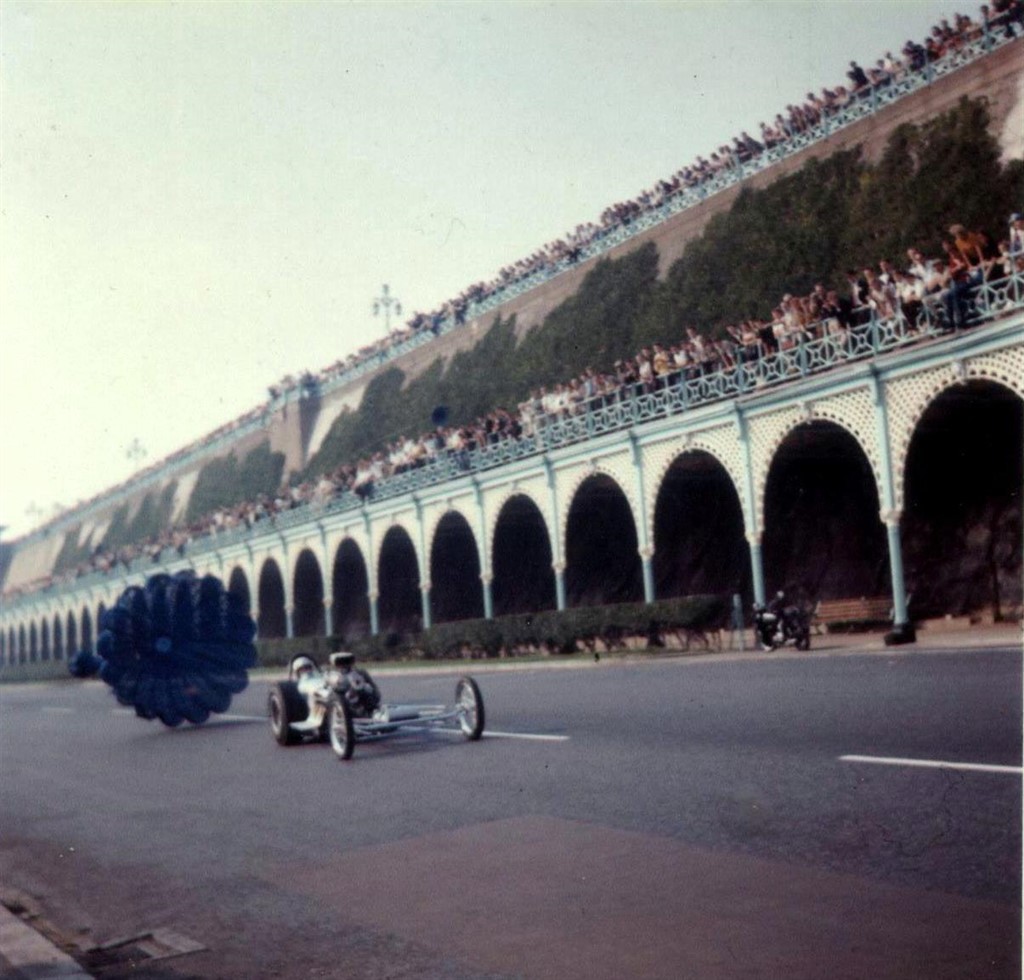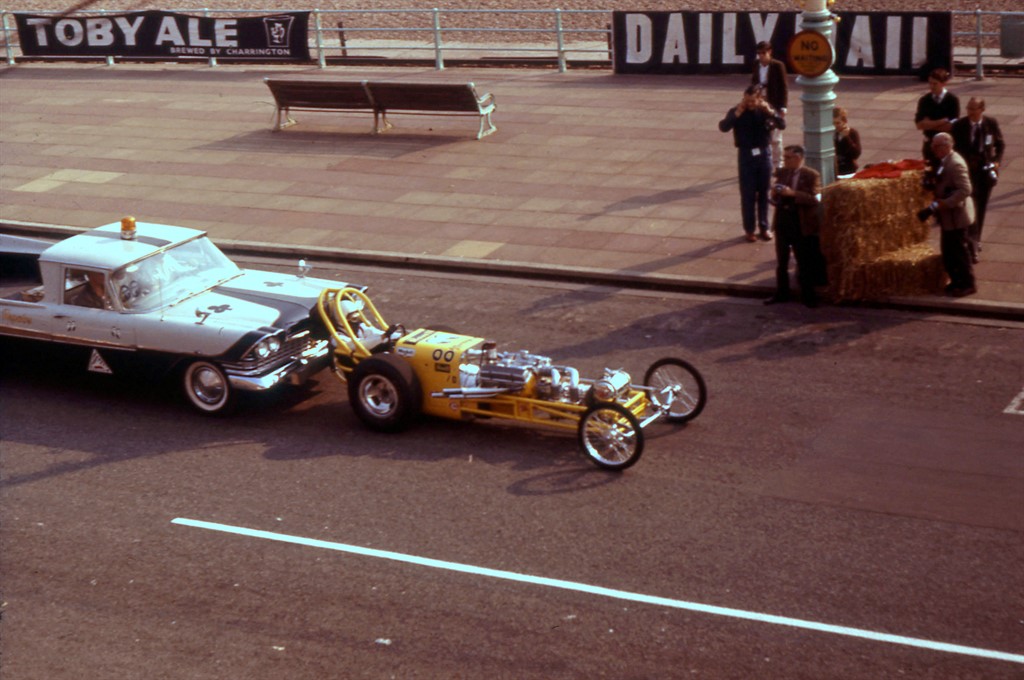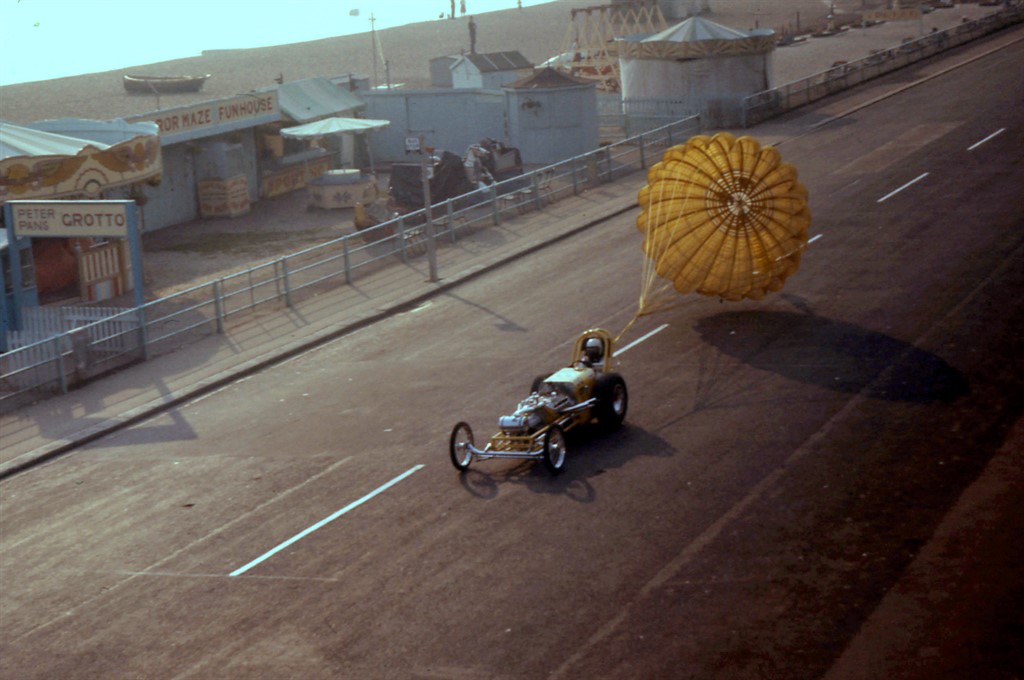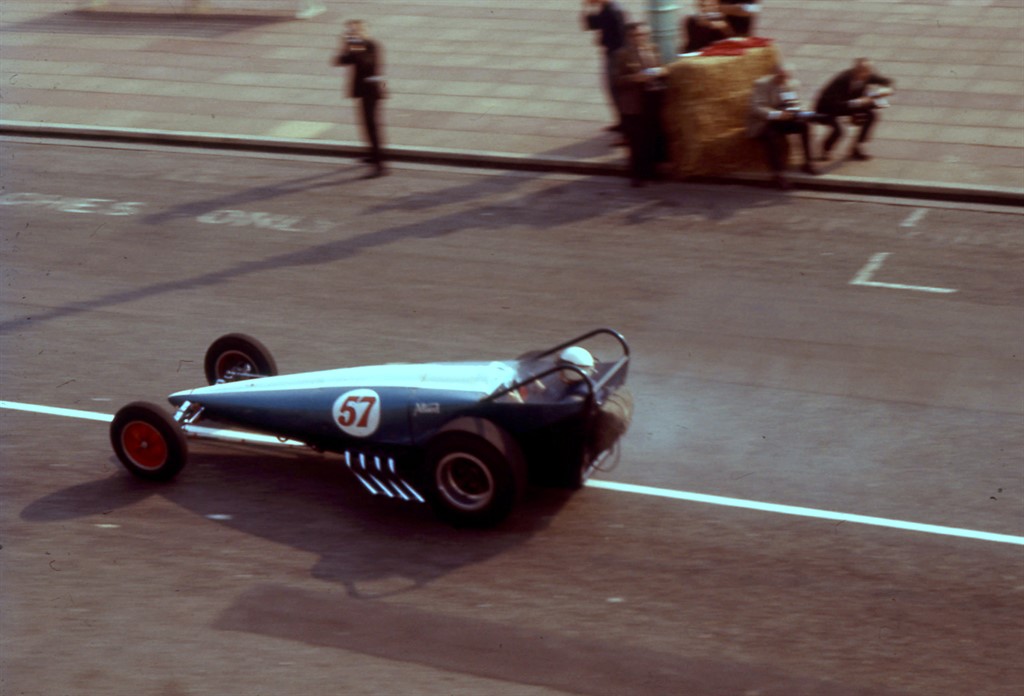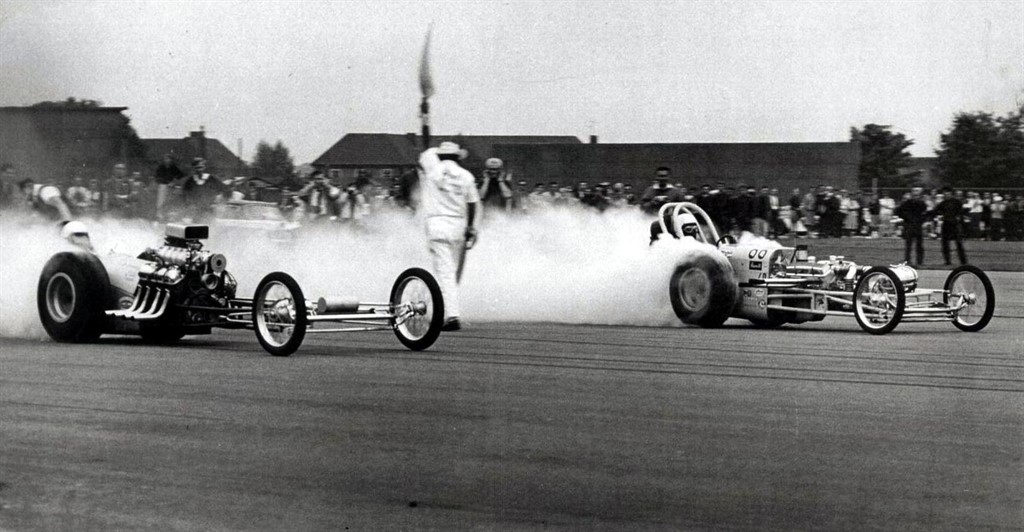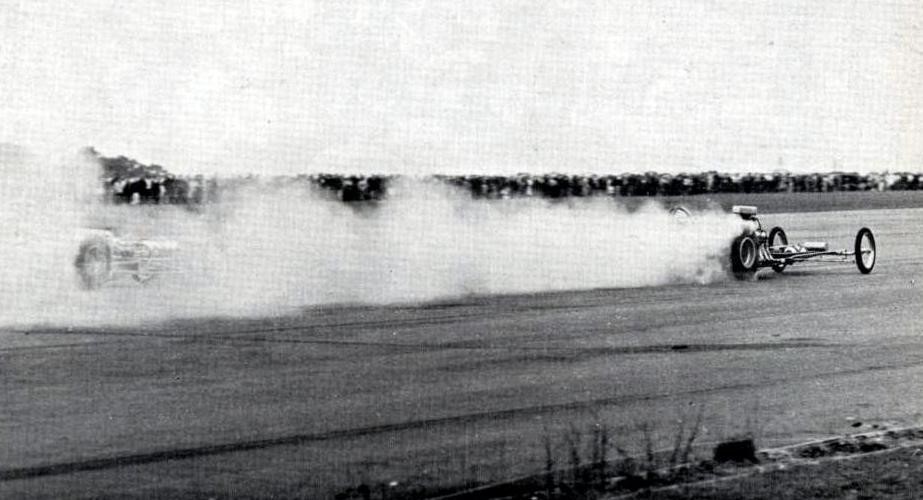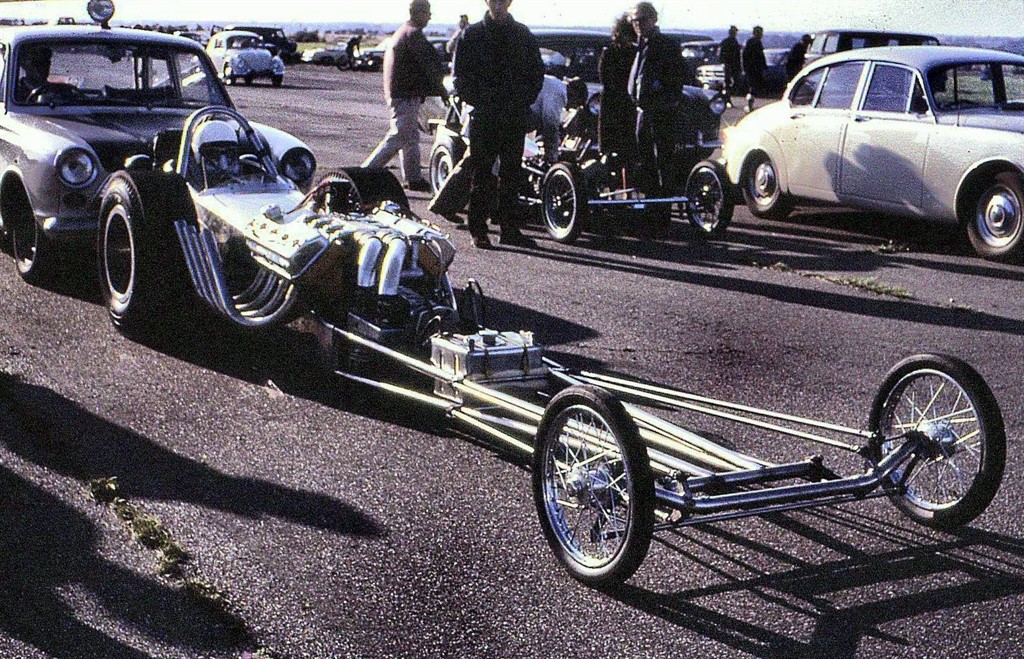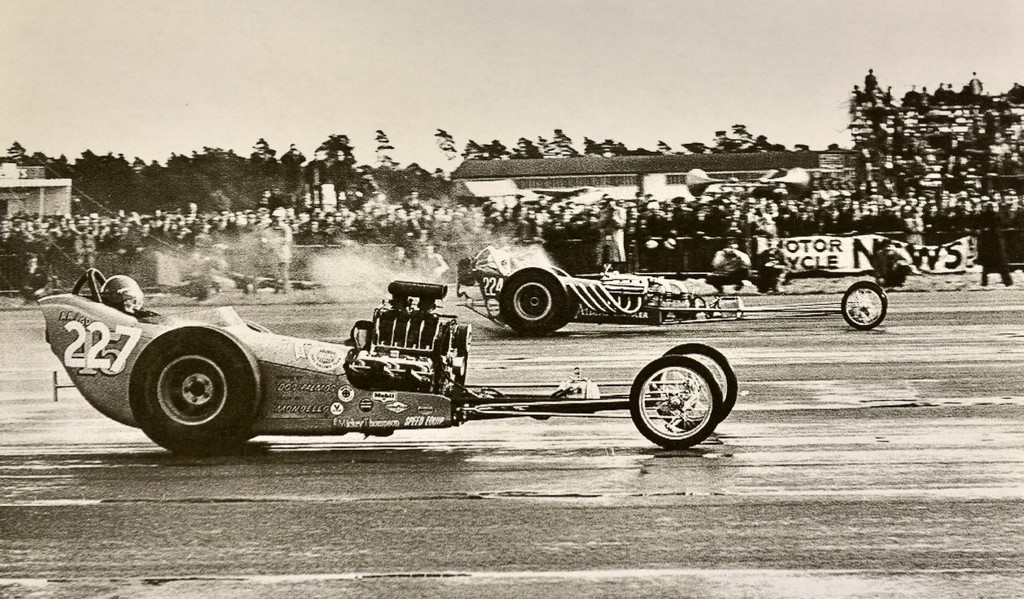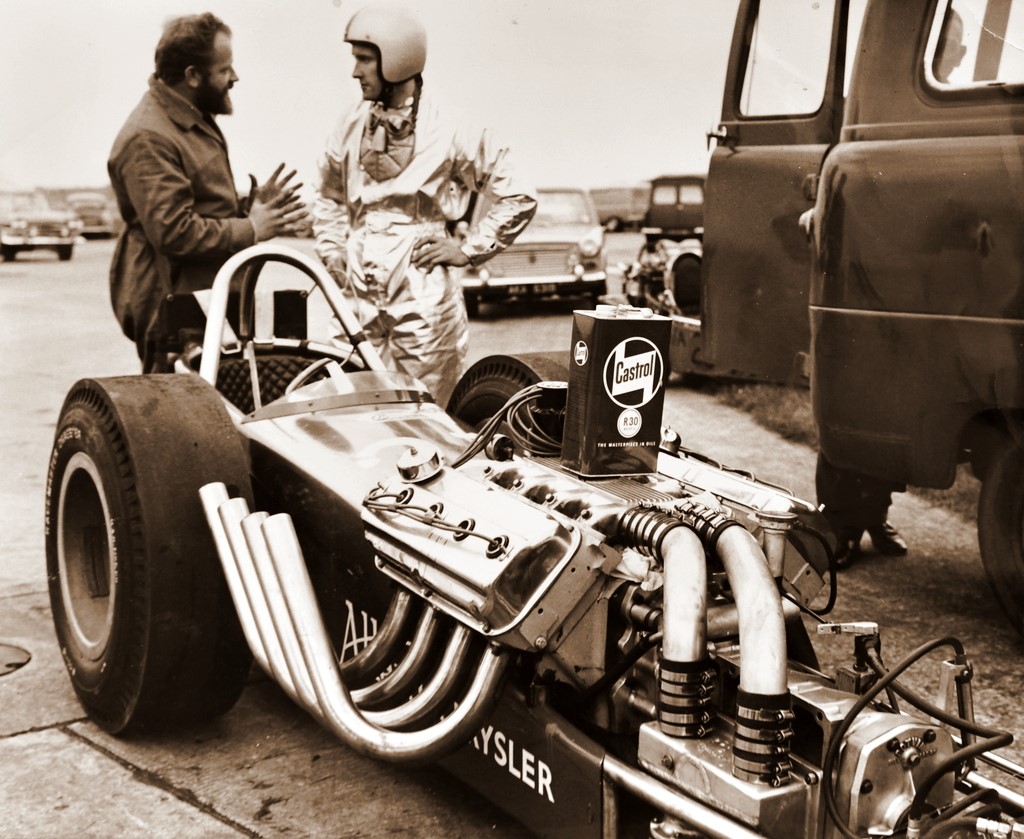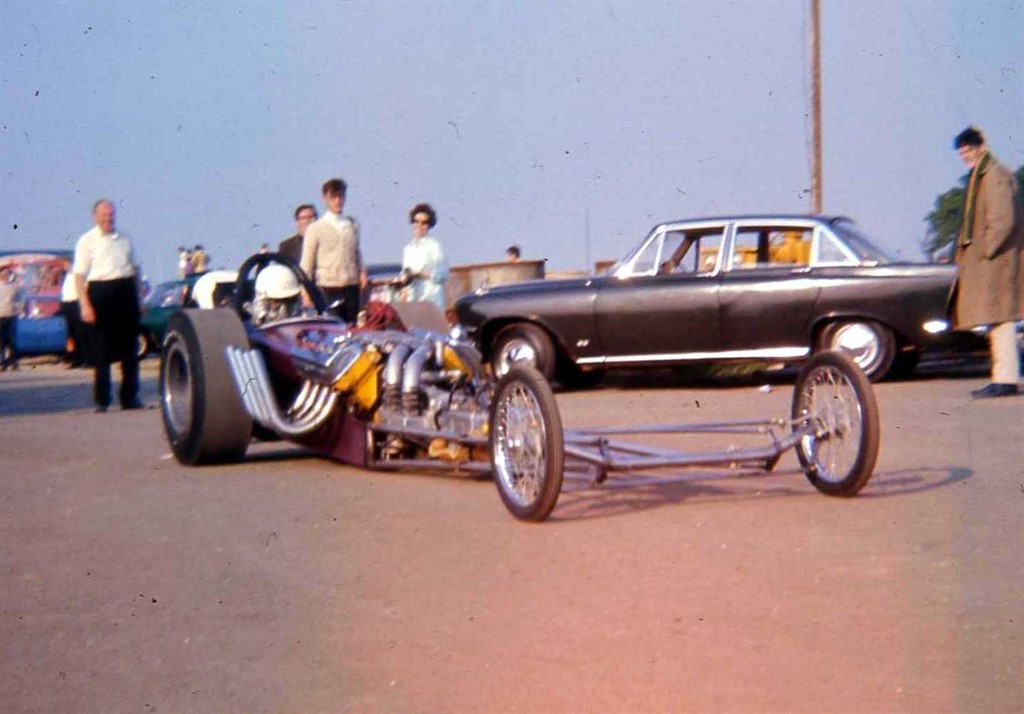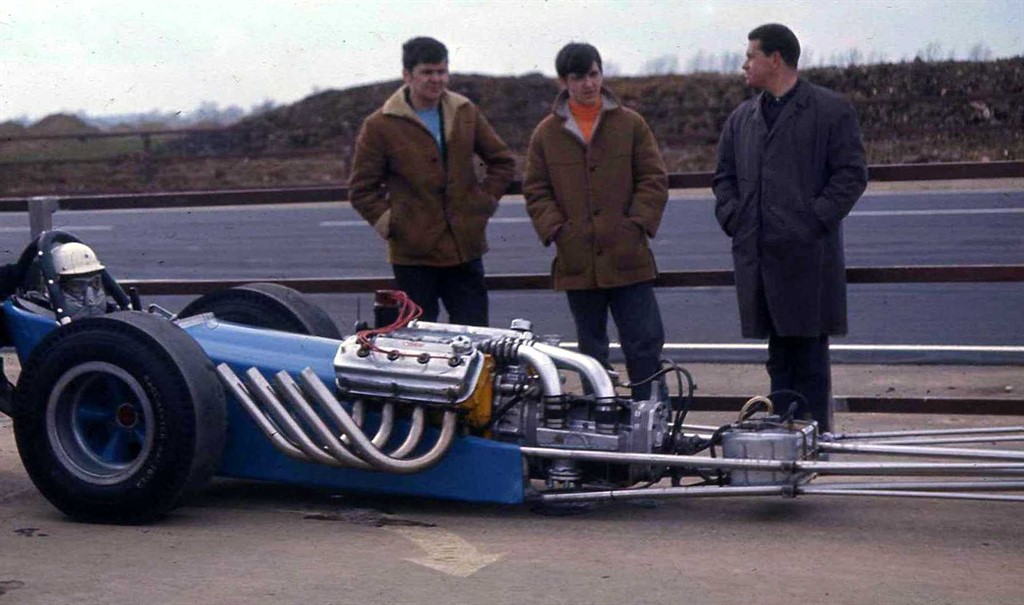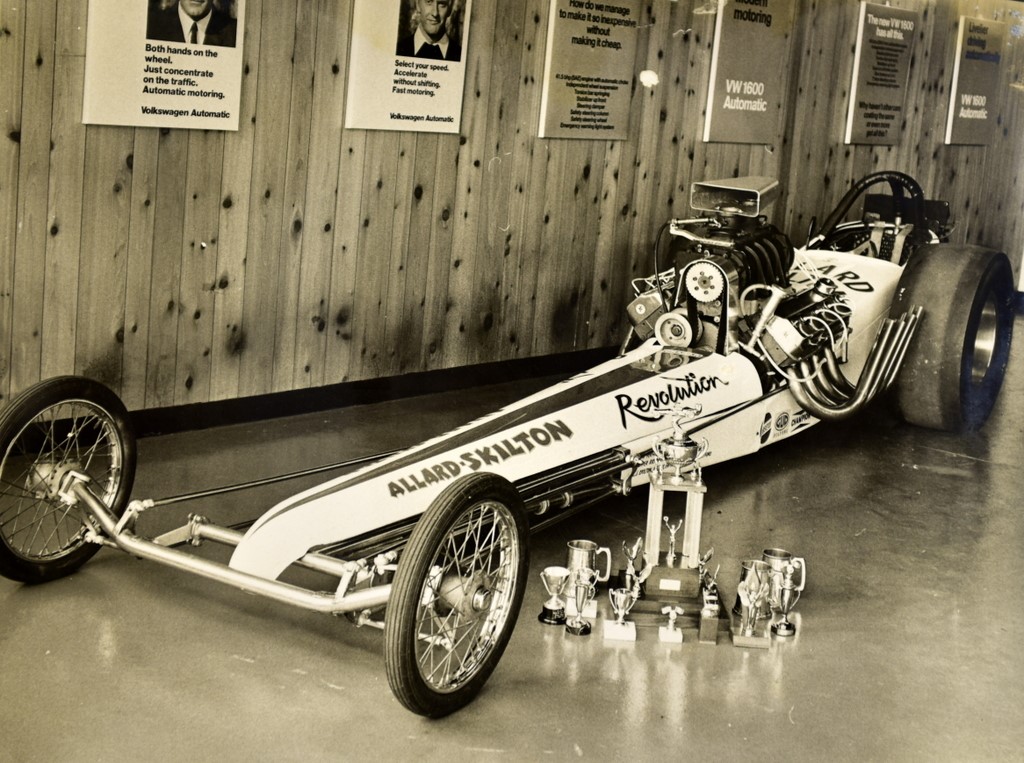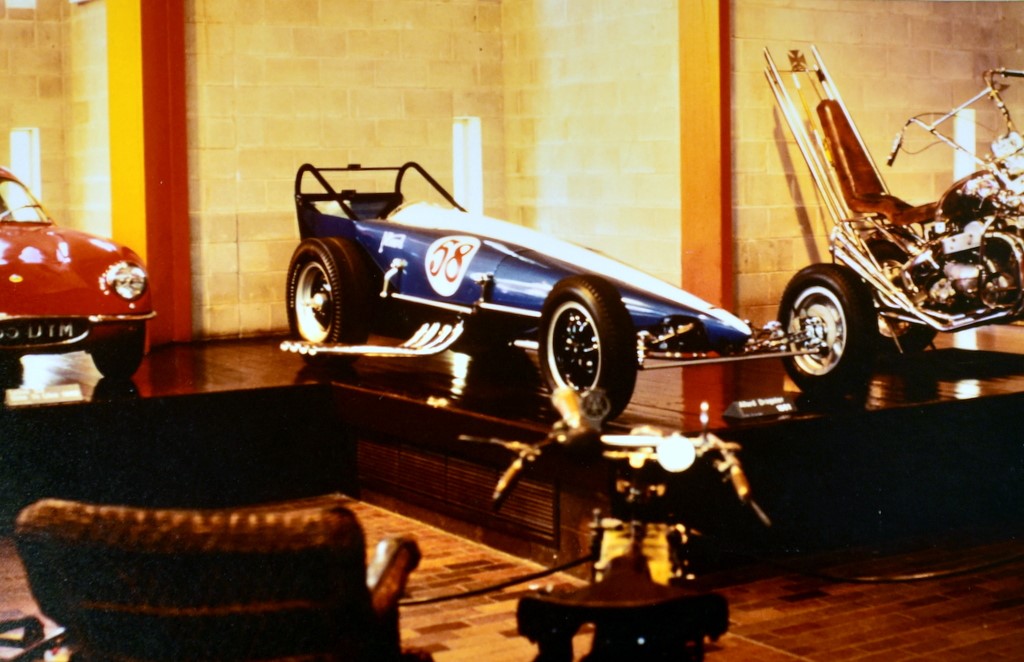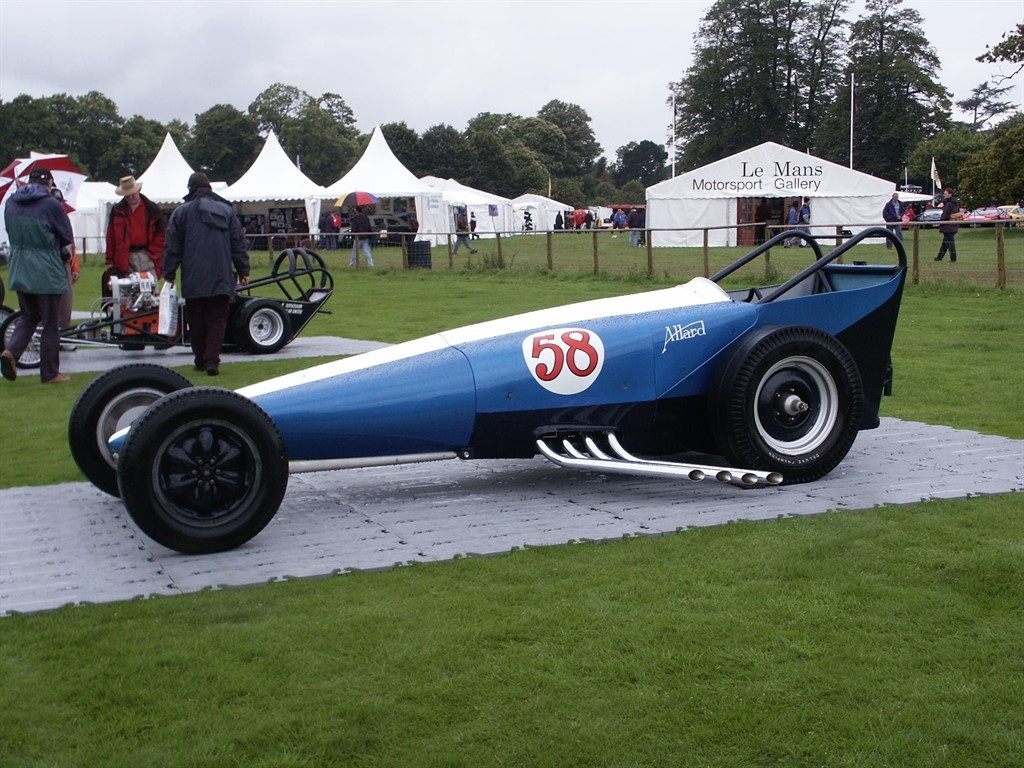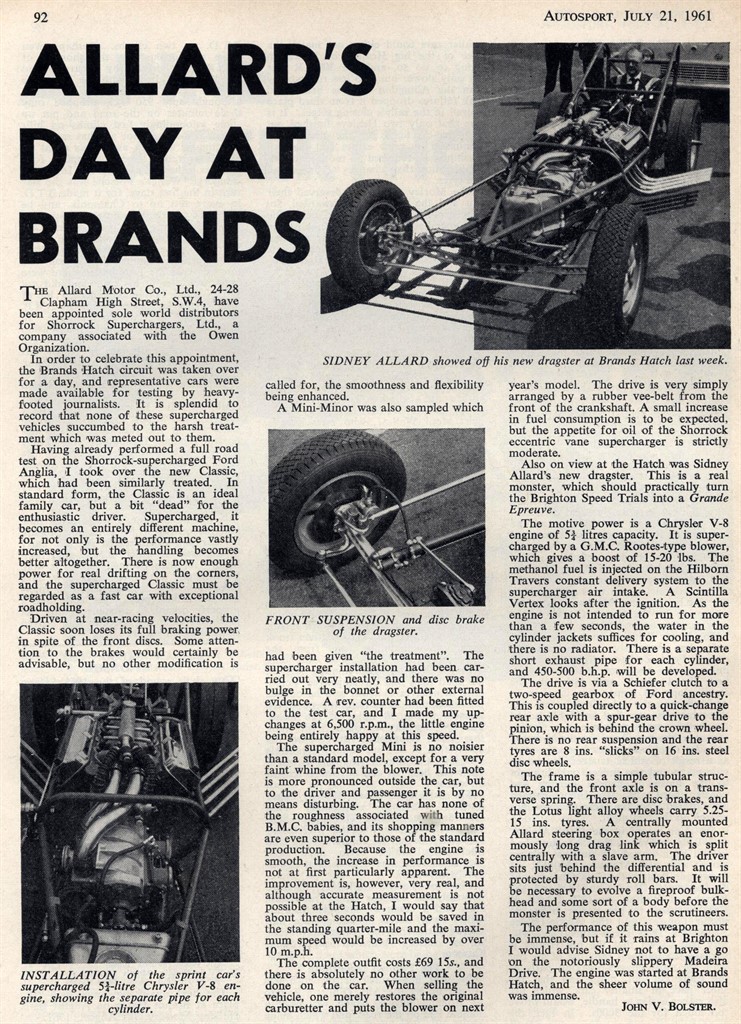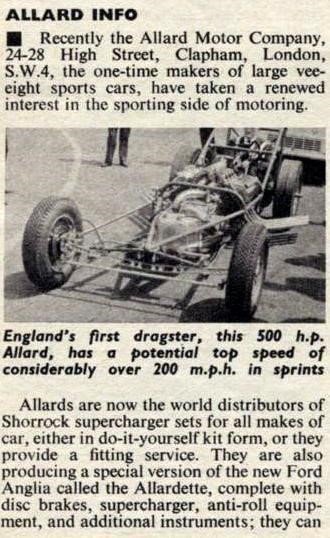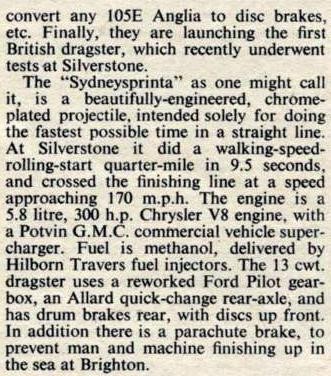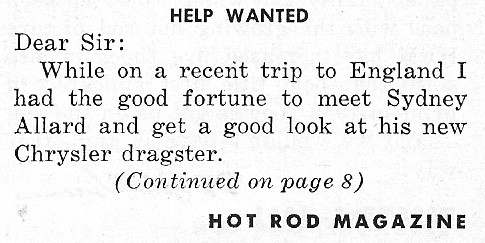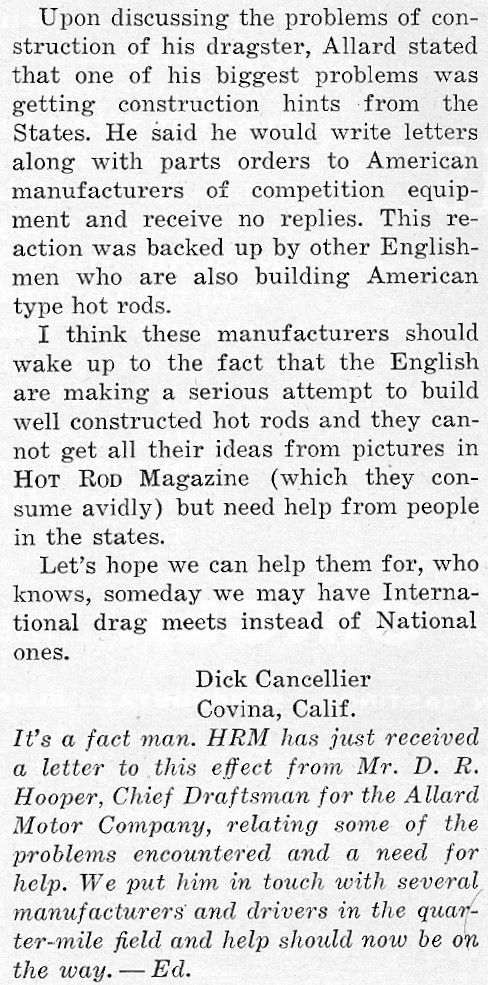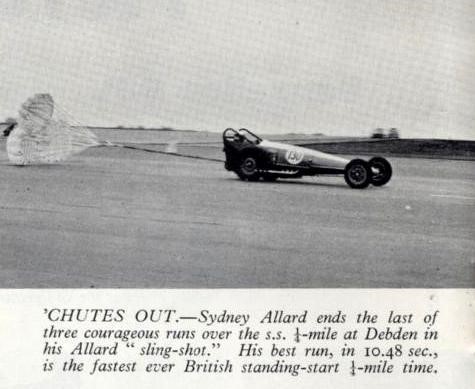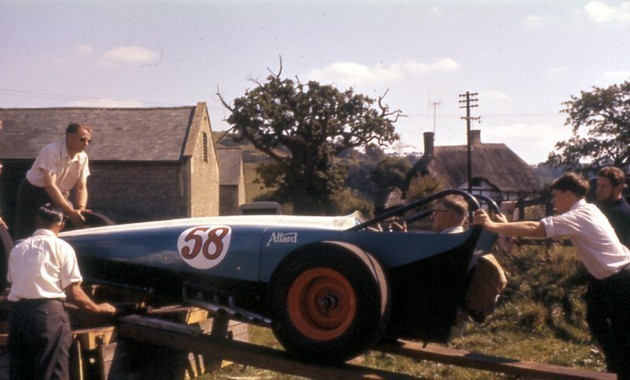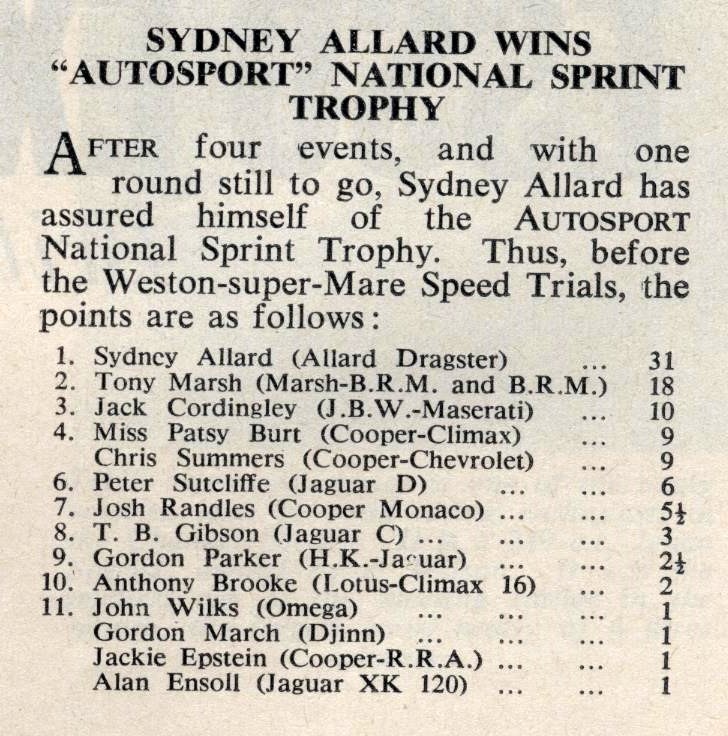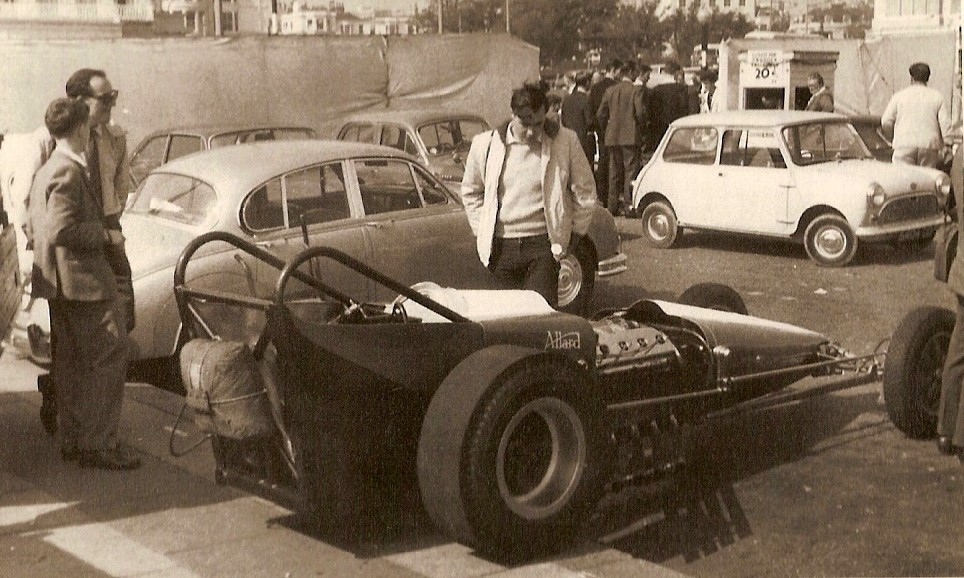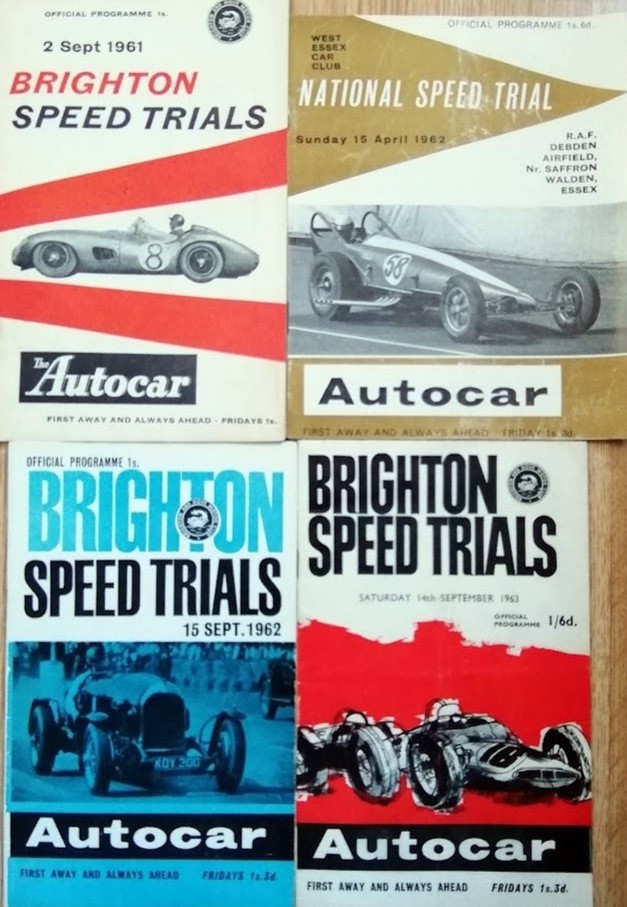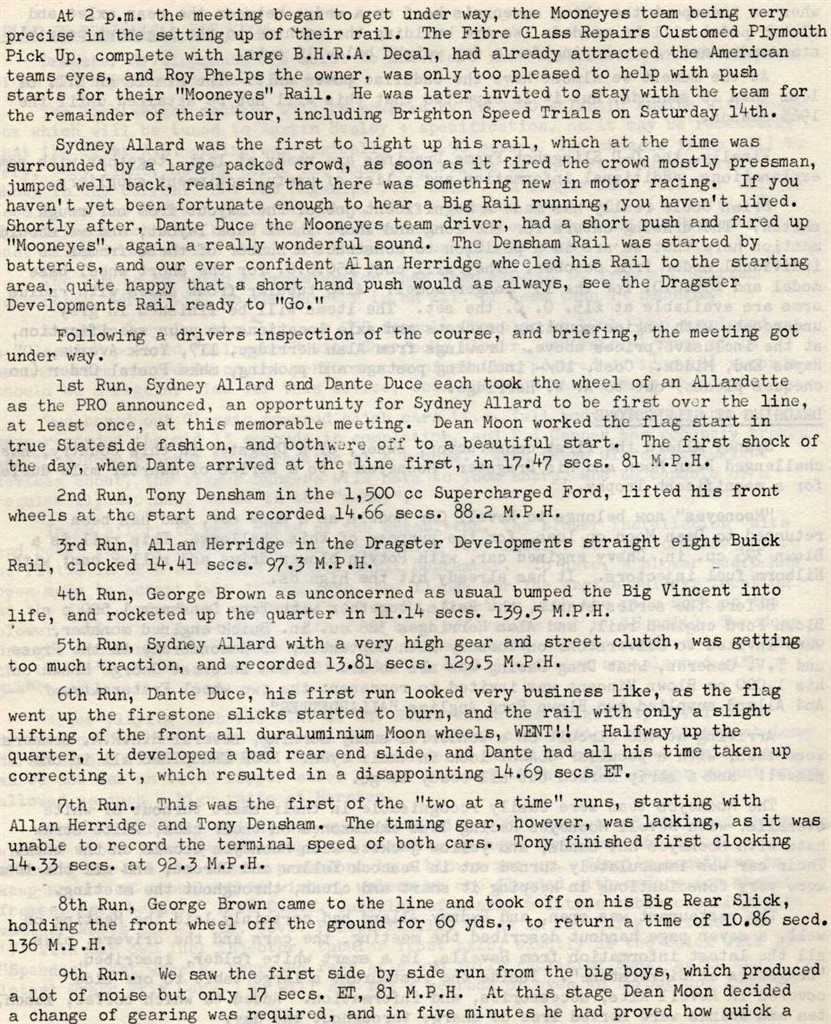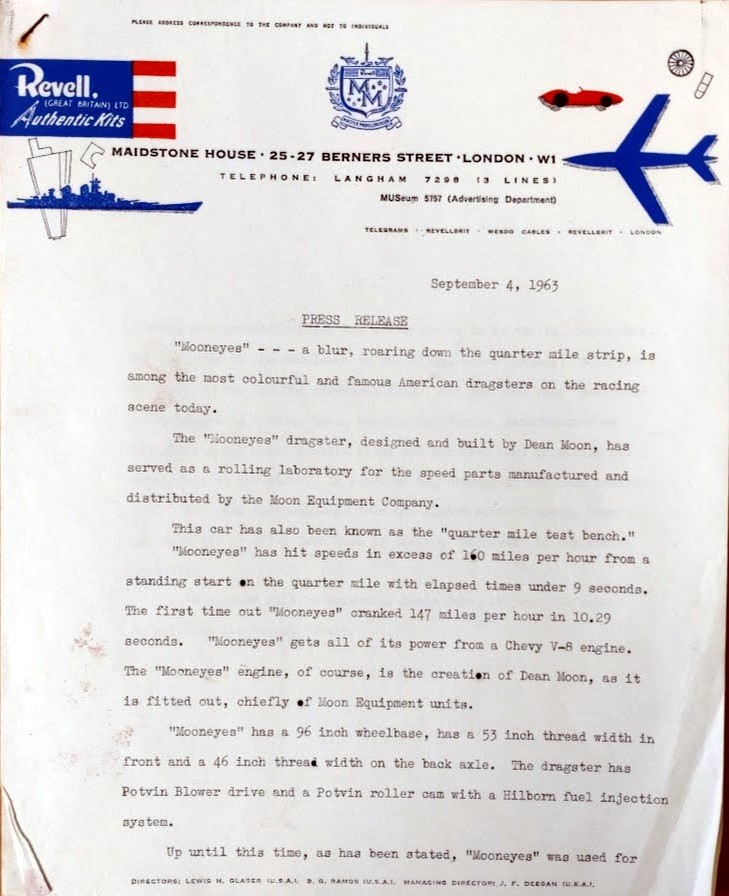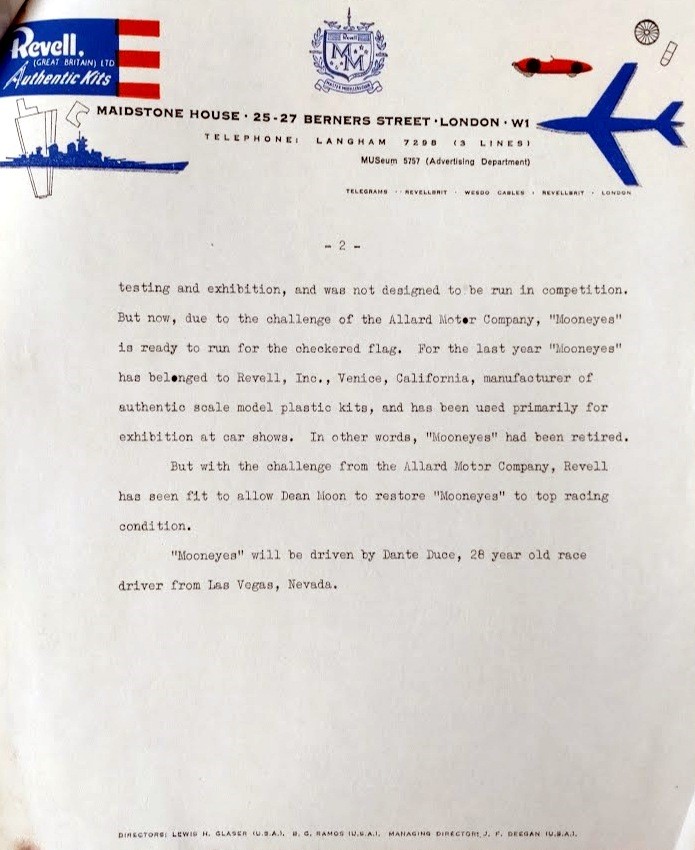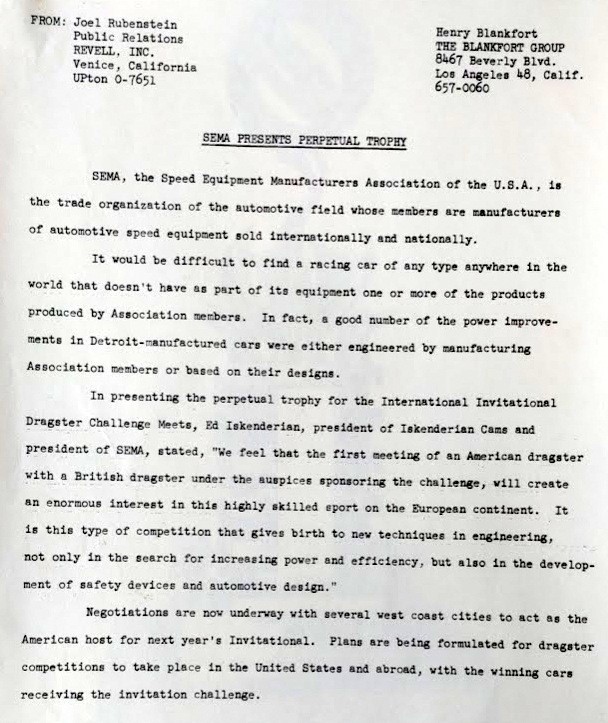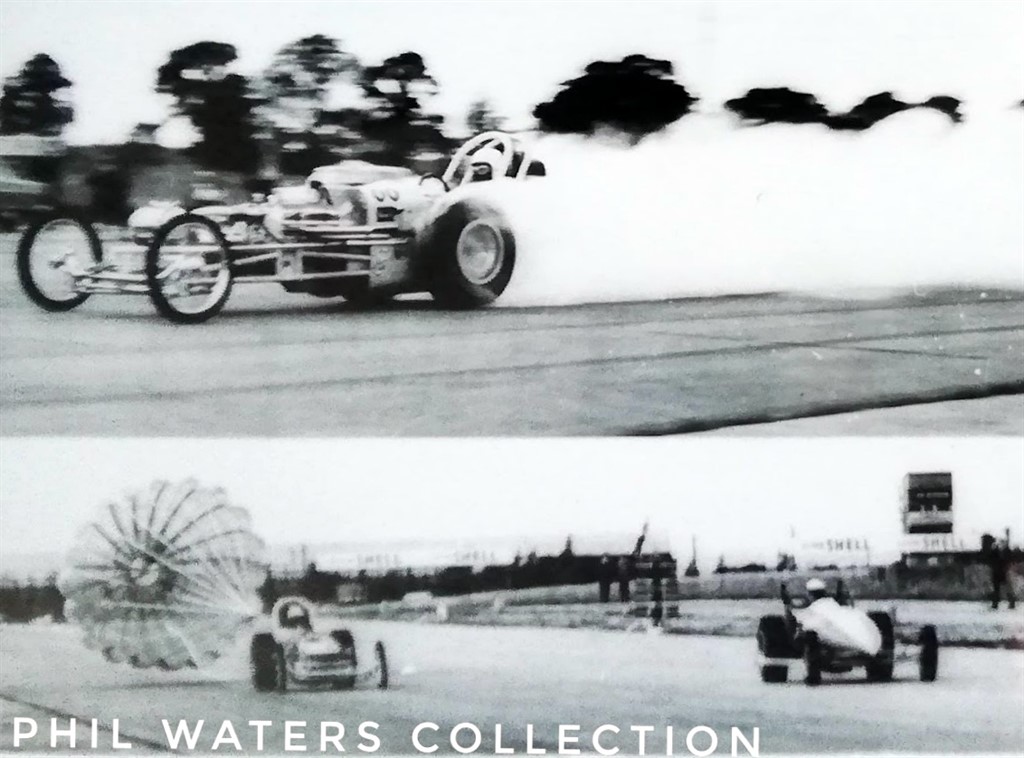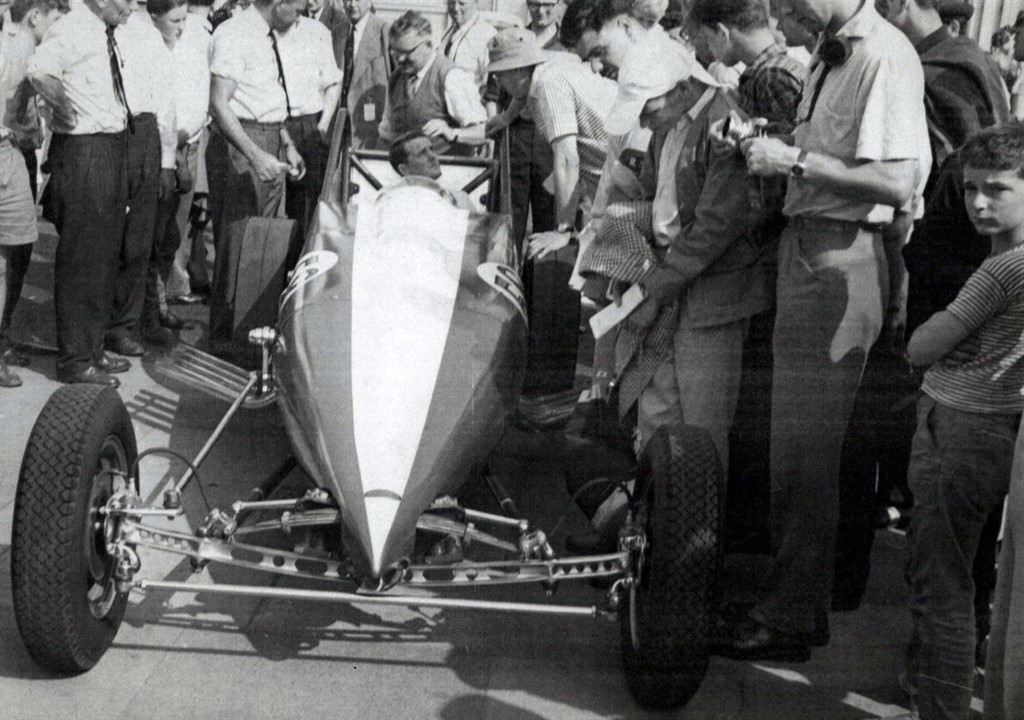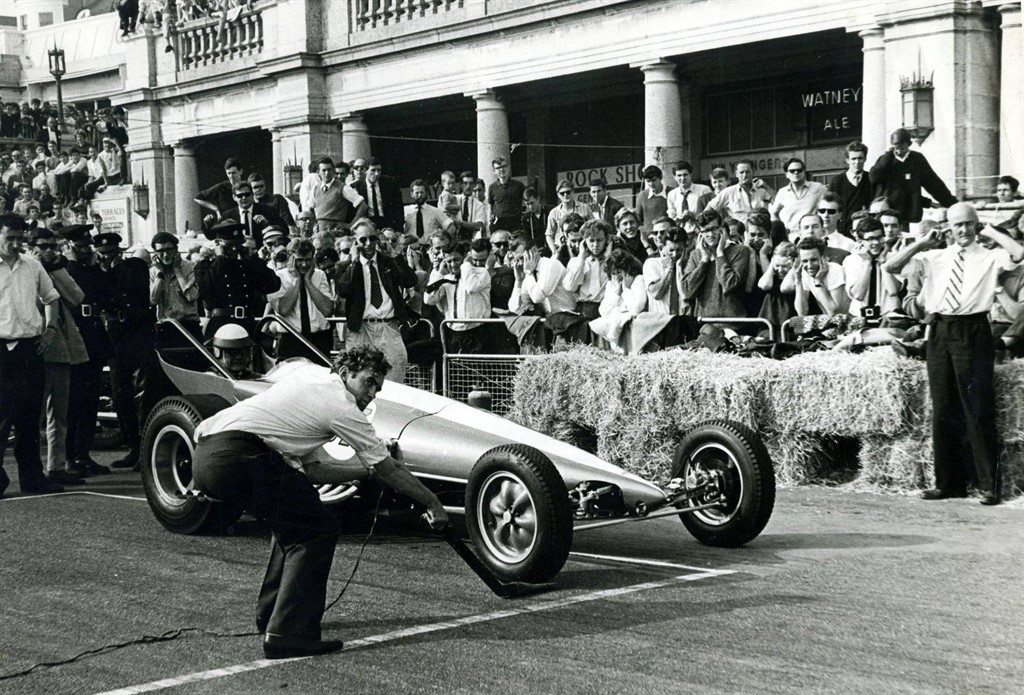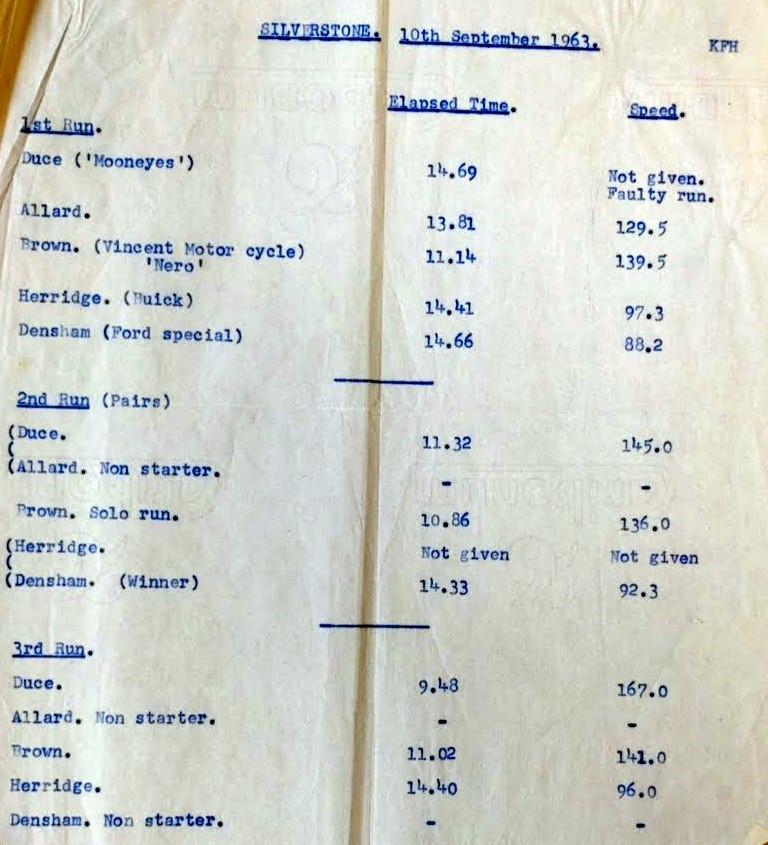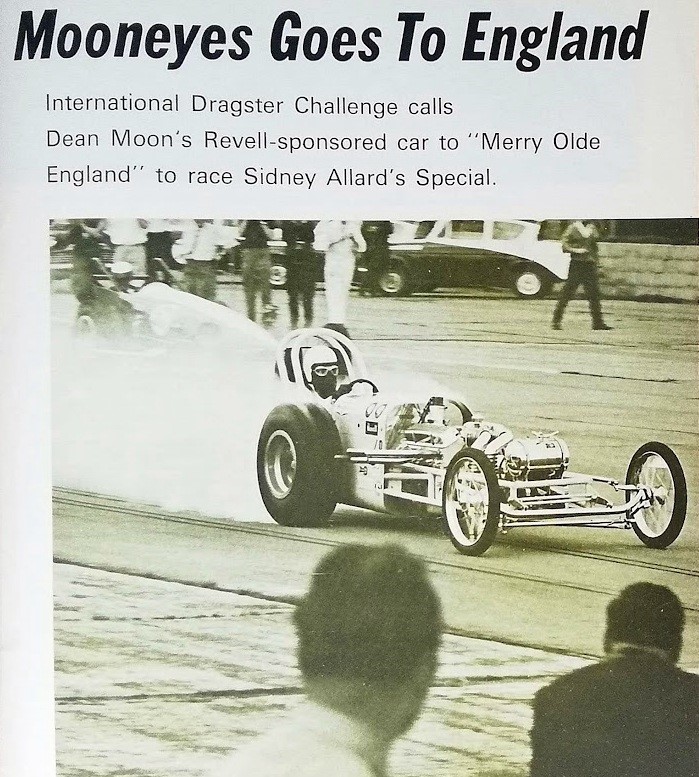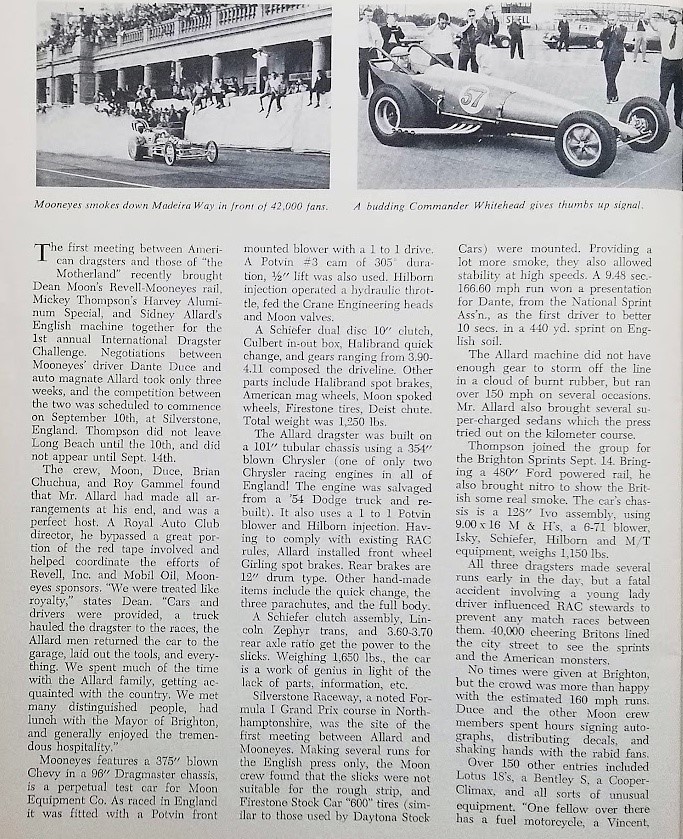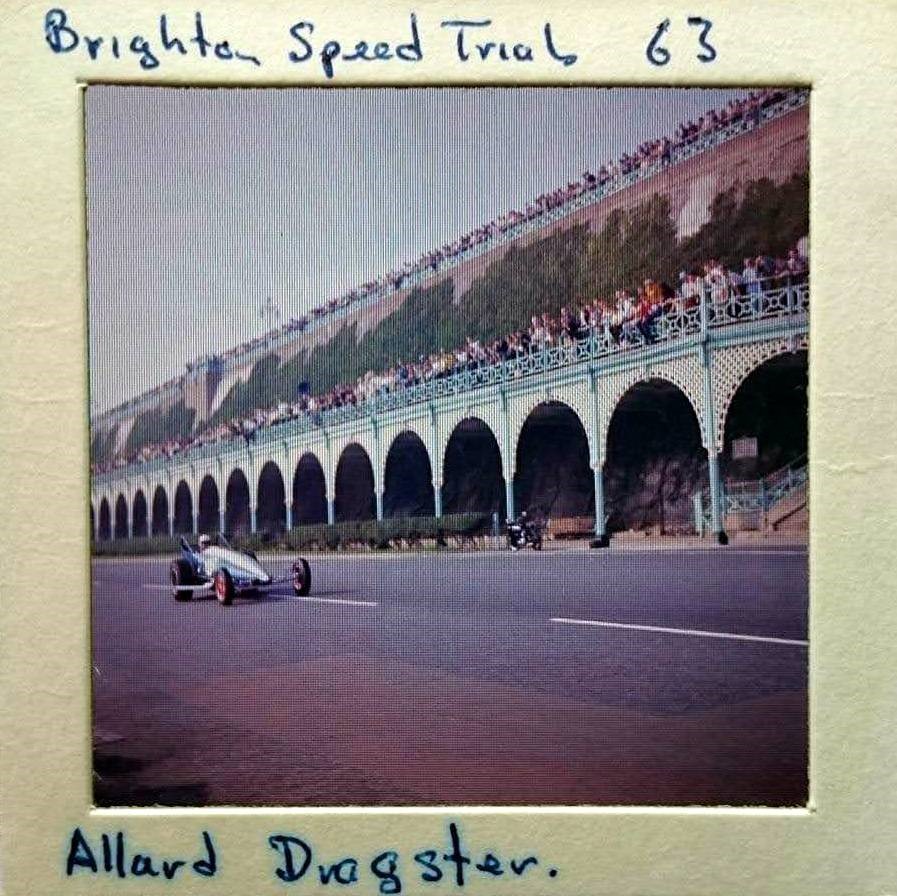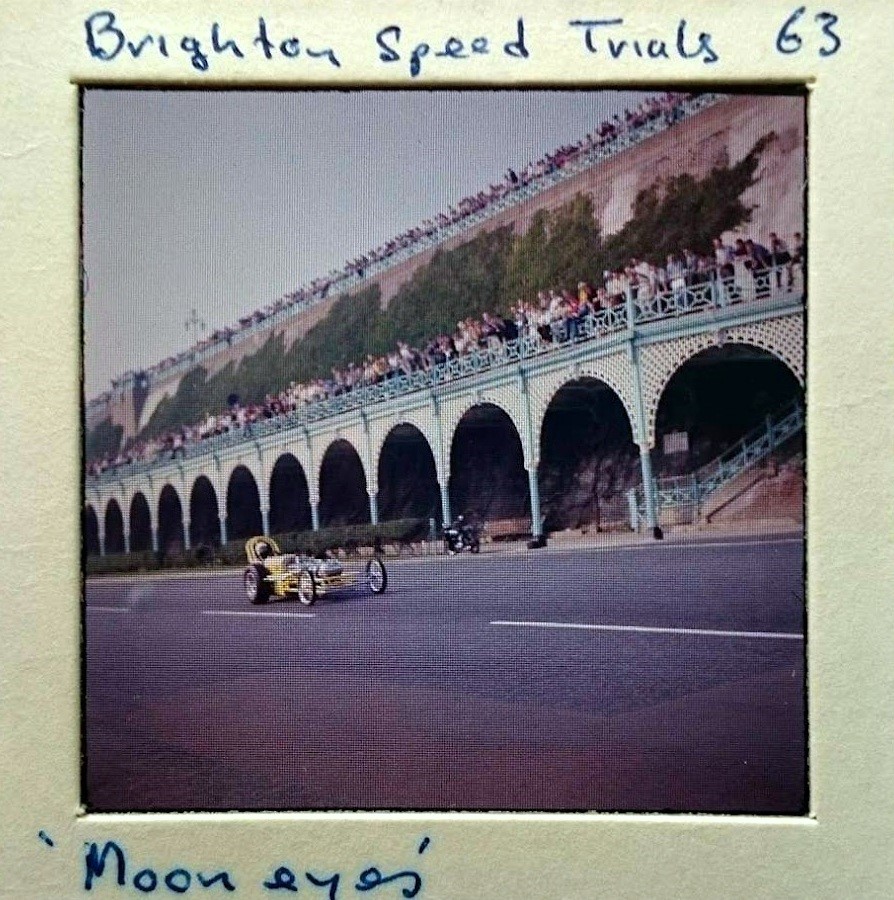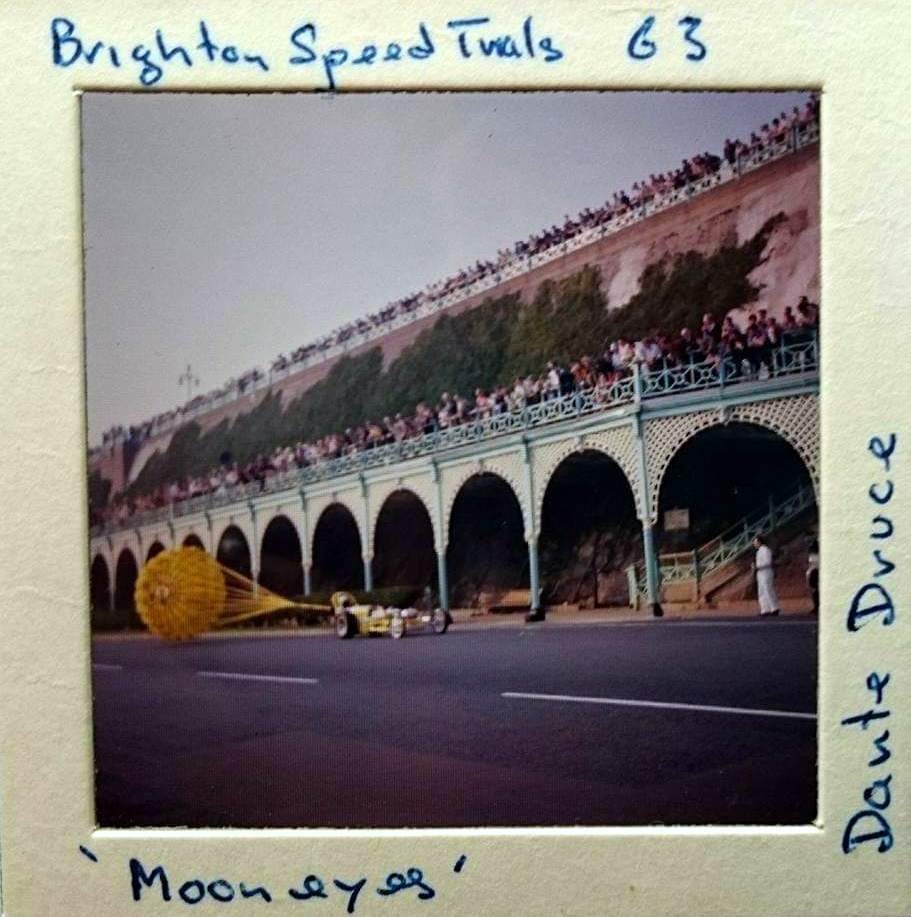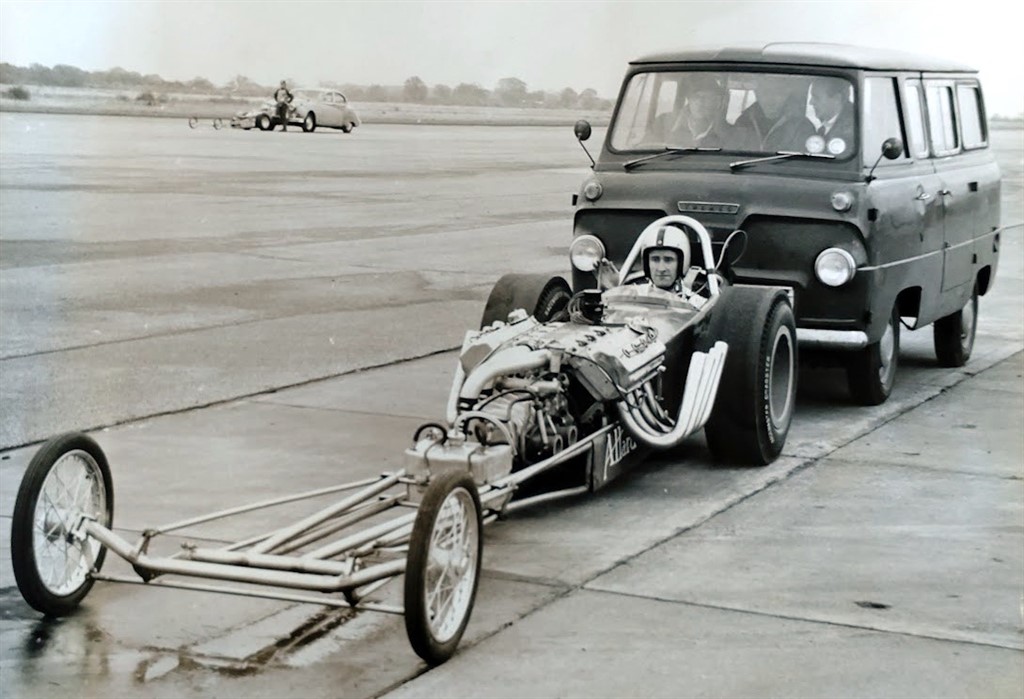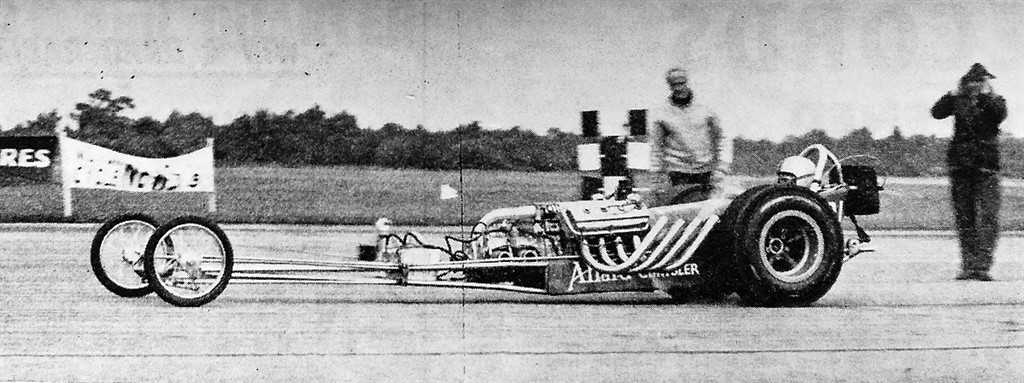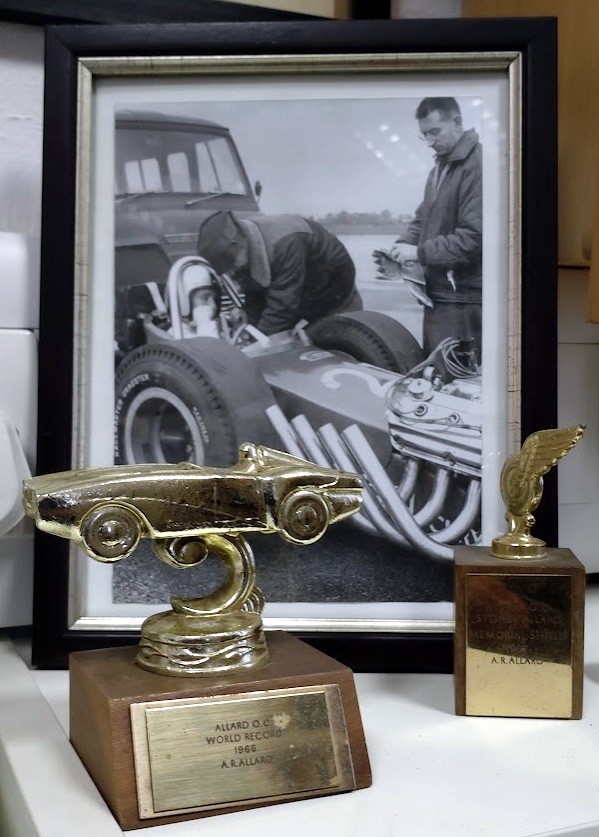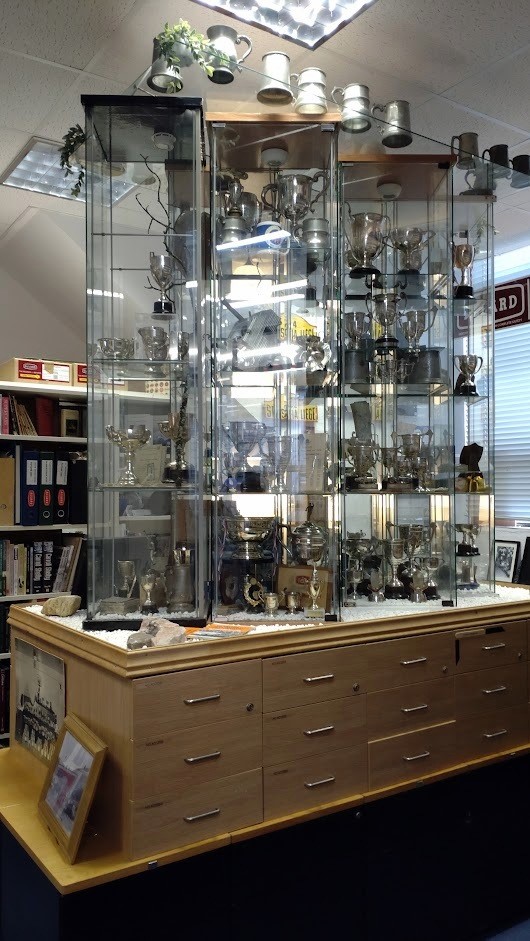Allard Chrysler Dragster Story
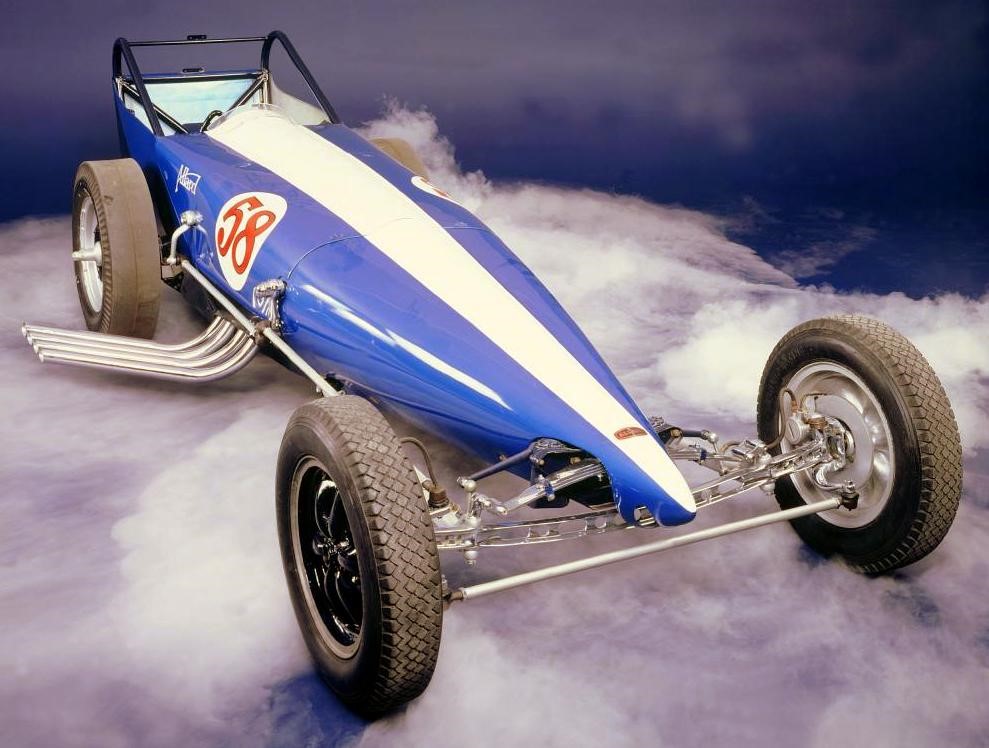
Story produced by Phil Waters with pictures added by Nick Pettitt.
SYDNEY ALLARD & THE ALLARD-CHRYSLER DRAGSTERS
From John Blunsden, writing in Hot Rod Magazine March 1962 edition, concerning Sydney Allard:
"Last autumn (1960) he made a decision. He would build an American-style dragster! That there was no drag racing in Britain concerned him little. His idea was to build the car, demonstrate it, and hope that sufficient interest might be evoked for the formation of a drag movement, possibly in conjunction with an existing motorcycle sprint group."
And so Sydney Allard set to work in January 1961, aided by designer David Hooper and chief mechanic John Hume. Just six months later, in June 1961, the Allard Chrysler dragster was complete - apart from the familiar aluminium bodywork.
|
|
The dragster's first public appearance was at a Shorrock Supercharger Demonstration Day held at Brands Hatch in early July. Allards had just been appointed sole world distributers for Shorrock and had a supercharged Ford Classic, an Anglia and Mini there for the motoring press to try out as well as the Allard Chrysler dragster as a static exhibit.
John Bolster reported in Autosport dated July 21st 1961
Also on view at the Hatch was Sydney Allard’s new dragster. This is a real monster which should practically turn the Brighton Speed Trials into a Grande Epreuve. The performance of this weapon must be immense but if it rains at Brighton I would advise Sydney not to have a go on the notoriously slippery Madeira Drive. The engine was started at Brands Hatch and the sheer volume of sound was immense.
This was followed by the official press launch at Silverstone on 24 July 1961 where the machine was to be demonstrated - albeit using rolling starts to conserve the temporary clutch.
Press folders were made available containing complete specifications of the car along with photographs. I was lucky to be able to obtain an excellent example - from French eBay of all unlikely places - and have copied the contents below.
A message from Sydney Allard
This is just to welcome you to our little party and to ask your indulgence if I can't get around to talk to everybody.
A word about what you're here to see. Today we launch, so to speak, the first British dragster. We have built this car to see what this up-till-now- All-American dragging business is all about, and to see if we can find it a place in British motor sport. (In passing "find a place", or venue, looks like being the first problem). If all goes well today, I think you will find that, whatever your opinion may be of the sport, what you will see and hear leaves little room for indifference!
Finally, you may well know by now that The Allard Motor Company has recently been appointed sole world distributors for all Shorrock supercharger installations, not just their Ford kits as before. If you weren't able to join us at Brands Hatch the week before last, you might like to try (after I've finished on mine!) a blown car for a couple of laps of the Club circuit.
I hope you have an enjoyable day.
24th July, 1961.
THE NEW ALLARD SPRINT CAR
In September 1961, Sydney Allard will appear on the Madiera Drive at the popular Brighton Speed Trials at the wheel of his latest and most sensational sprint car to date. The new car, which is based on the conception of the American sprint "dragster" is nearing completion at Allard's experimental workshops in South London. For his version of the "dragster" Sydney Allard is remaining faithful to the V-8 engine, using a 5 3/4 litre Chrysler unit which will be supercharged. Allards have considerable experience of supercharging, being world distributor of the Shorrock Supercharger installation for Ford cars.
Because the length of the American "drag-strips" allow long pull-up areas, their cars are fitted with rear wheel brakes only. However, the close confines of the English sprint venues, particularly Brighton, will demand disc brakes on the front wheels of the Allard car as well. It is highly likely that a driver-operated braking parachute will also be used to assist in bringing the car to a safe halt after its run.
The car is being built by John Hume, 33, Allard's racing mechanic, in close consultation with Dave Hooper, 28, Chief Draughtsman of The Allard Motor Company, and Sydney Allard himself. First trials of the car are scheduled for the early summer, probably at Silverstone, a demonstration run for the benefit of the press at the same venue will be held at a later date.
Technical Note
The American dragster is sometimes called a "slingshot". This is because the bulk of the car - the engine, transmission and driver - is grouped around the back axle to obtain maximum grip of the rear wheels on acceleration, the driver himself sitting behind the axle in a protective framework of tubing - in the "sling" as it were. The majority of these cars carry little or no bodywork on the simple tubular framing and, as the sprints seldom exceed the quarter mile, no radiator is required. To save weight, the front wheels are often motorcycle equipment of the lightest variety. The rear wheels, however, have to transmit anything up to 600 brake horsepower and 12" wide treadless tyres, or "slicks" are fitted. The latest American record for the standing 1/4 mile is 8.84 secs. the car crossing the line at 172.08 m.p.h. The magic 200 m.p.h. has been achieved a number of times though never officially recorded.
Those Names:
Besides controlling THE ALLARD MOTOR COMPANY LTD, Sydney Allard is also Chairman and Managing Director of ADLARDS MOTORS LTD, Main Ford Dealers of Brixton, South West London.
For further information ring G.B. Belton at MACauley 3201.
THE CAR : SPECIFICATION
ENGINE:
- Make – Chrysler
- Capacity - 5803 c.c. (354 cu. in.)
- Cylinders - V-8 Bore & stroke - 3.94 x 3.63 in.
- Compression ratio - 8:1.
- B.h.p. - 480 @ 5000 r.p.m.
- Torque - 550 lb.ft, @ 3000 r.p.m.
- Ignition - Scintilla Magneto
- Plugs – Champion
- Fuel - Methanol mixture
- Supercharger - 6.71 G.M.C. (Root-type)
- Boost – 20 lb. Sq. In. (theoretical max.)
(A Shorrock supercharger will be used when available)
TRANSMISSION:
- Clutch - Schiefer 11" dia.
- Gear ratios -
- Top 1:1
- 1st 1:1.61
- Rear Axle - Allard quick-change with transfer gears giving the following ratios:- 2.8 - 4:1.
- Rear hubs - Fully floating
- Differential - Conventional non-locking
CHASSIS:
- Main tubes - 3" dia.
- Roll-cage and bracing tubes - 11⁄2" dia
BRAKES:
- Front 9.11/16" discs. Rear 12" dia x 1 3/4" wide drum
SUSPENSION:
- Front - beam with transverse leaf Armstrong lever type adjustable shock absorbers
- Rear - None
STEERING:
- Roller and worm in conjunction with divided drag link and idler arm.
TYRES:
- Front 5.25 x 15" Dunlop racing
- Rear 800 x 16" American slick
July, 1961.
|
THE ALLARD DRAGSTER
The Allard dragster, the first British designed and built version of the fabulous American sprint cars, was laid down at Sydney Allard's South London workshops in early January of this year. In June, only twenty-three weeks later, trials commenced at Silverstone culminating in a demonstration before the press and T.V. cameras on Monday 24th July.
At this function Sydney Allard stated that his purpose in building the car was to investigate the spectacular American sport of dragging (that is, sprinting over the standing quarter mile) with a view to promoting interest in this country of an event hitherto unknown in Britain.
The men behind the car
The Allard dragster has been built by Allard's development engineer, John Hume. Hume, 34, joined the Company in November 1960 and his career in motor racing has included 5 years as Chief Racing Mechanic with Coopers.
Design work on the car has been in the hands of Dave Hooper. 28, Allard's Chief Designer, who has 11 years with the Company behind him.
As always, the whole operation has been carried out under the genial but exacting eye of the "Guv'ner", around whose 6' 2 1/2" bulk the car has been built.
FIRST DEMONSTRATION OF ALLARD DRAGSTER
On Monday 24th July, 1961, some forty journalists from the national provincial and motoring pross gathered at Silverstone circuit for the first demonstration of Sydney Allard's new dragster. Television cameras from I.T.N. were also present.
In ideal weather conditions, Allard did a total of nine runs over a timed quarter mile up the gradient of the Club Circuit straight from a start line on Woodcote Corner. Using top gear only, Allard clocked a best time of 9.5 seconds on his second run. The highest speed was at the end of the seventh run, when the car covered the final 50 yards of the quarter mile in 0.6 seconds, approximately 160 m.p.h. (According to the latest available information published by the National Hot Rod Association, the American record for the E.T. and finishing speed stand at 9.0 seconds and 174.4 m.p.h. respectively. This is after four years of drag experience).
On returning to the start after his first run, Allard reported crossing the hill at the end of the Quarter mile at over 140 m.p.h. to find two large sows leisurely crossing his path followed by two herdsmen. Having no time to stop or deviate from his course, he passed within a few feet of the animals at a speed still in excess of 120 m.p.h. Afterwards one of the drovers was heard to express his concern at the effect the incident might have on "two valuable animals - one in pig, and all".
For further information and photographs, ring G.Belton, MACaulay 3201
|
|
|
|
|
|
|
|
From Motor Sport Magazine September 1961
THE ALLARD DRAGSTER
"There is no more appropriate driver than Sydney Allard when it comes to dragsters, for Allard always has loved ’em big and fierce. His, the first British dragster, or pure sprint special, designed by D. Hooper and built by J. Hume, was demonstrated to the Press at Silverstone in July. It made a great many exciting onslaughts on a s.s. 1/4-mile, finishing the distance at speeds variously estimated to lie between 150 and 170 m.p.h., the noise from the stub-exhausts of its G.M.C. Roots-blown 5.8-litre V8 Chrysler engine considerably enhancing the performance, before the gearbox broke up. This Allard is a full “sling-shot,” copy of the best American dragsters. It is beautifully finished, with a frame of 3 in. dia. main and 1 1/2 in. dia. rollcage tubing. There is no rear suspension, and the axle is held to the underslung frame merely by welding. Allard sits at the extreme rear, with his legs cranked up over the axle, the back of the final drive casing being wrapped in sponge-rubber as some small concession to his comfort, perhaps at his wife’s request....
The front axle is a drilled beam sprung on a transverse spring and damped by Armstrong shock-absorbers. The worm and roller steering incorporates an extremely long drag-link. Lotus front wheels carry 5.25 x 15 Dunlop racing tyres and the back wheels are shod with 8.00 x 16 flat-tread American slicks. The contraption is stopped by 9 11/16 in. disc front and 12 in. x 1 3/4 drum rear brakes supplemented by an Irving drag-parachute.
It will need some stopping, for the engine, on a boost of some 12 lb./sq. in. and an 8.5 to 1 c.r., develops 480 b.h.p. at 5,000 r.p.m. and 550 lb./ft. torque at 3,000 r.p.m. and it runs up to 6,000 r.p.m. It consumes Distiller’s methanol fuel, injected into the blower on the Hillborn system, at about 1 m.p.g., uses Champion plugs, and a Scintilla magneto and drives via a long-suffering 11-in. Schiefer clutch and a 2-speed gearbox with Ford gears, giving ratios of 4.0 and 2.8 to 1. The coolant is contained in the water jackets only, there being no radiator. The back axle also incorporates Ford gears and has fully-floating hubs to obviate shedding wheels if the half-shafts break, and a normal differential. The car gets off in a straight line with very little wheelspin. It is over 100 b.h.p. down on the American dragster that has clocked 8.84 sec. for the s.s. 1/4 mile, finishing its run at over 172 m.p.h.
Allard will have a tough task at Brighton and before you consider this dragster a cinch for the course record remember that it has to go more than twice the distance run on test and be held at some 170 m.p.h. over the bumpy end of the Madeira Drive kilometre course. We shouldn’t be surprised to find the parachute full of policemen’s helmets and marshals’ hats at the finish, while the noise, echoing back from the promenade buildings, should make the kids cry for a week thereafter – what price rival Eastbourne’s P.R.O. instituting a “silent holidays” slogan! So you must bear with the intrepid Sydney Allard at Brighton on September 2nd, where he has guaranteed to run, wet or fine.
|
|
|
|
|
|
|
|
The Brighton Speed Trials held on 2 September 1961 saw the first public event for the Allard Chrysler dragster. Unfortunately, the car was beset by problems which rather spoilt the occasion.
Motor Sport Magazine editor William Boddy was scathing in his review:
"On September 2nd under a hot sun tempered by a mild breeze, competitors and holidaymakers mingled motorcyclists in jerseys and leathers with briefly-clad girls-to watch the main attraction: Allard's blown 5.7-litre Allard- Chrysler dragster. They were in for bitter disappointment. This smartly-finished freak, now wearing pointed-nose bodywork - a sort of gentleman's touring version of the skeleton American slingshots -for which the optimistic, Allard himself included, predicted a time in the region of 22.1 sec. sounded healthy in the paddock but proved temperamental on the line, took off, hesitated, gathered speed, to complete its run with the mixture delivery pipe to one bank of cylinders adrift, a trouble experienced in trials at Boreham, time 37.91 sec. The three pre-1914 cars in the same class, Sears' ex-John Norris Benz, the Fiat "Mephistopheles" and Fitzpatrick's Metallurgique easily bettered this, averaging 34.65 Sec! On his second attempt Allard fluffed out in a matter of yards and, granted a third run, plugs again changed, couldn't even get the engine to start. The cameras waited in vain up the course to see him stream his parachute. Fiasco! Less pre - Brighton publicity would have made it less of a disappointment."
Sydney's revenge was sweet though, barely one month later at the NSA Records Day held at Wellesbourne. Denis Jenkinson wrote the following in the November 1961 issue of Motor Sport:
"Sydney Allard pointed the sleek blue dragster down the quarter-mile, let in the clutch, opened up and with a sound like a large bomber going down the runway disappeared through the timing traps. Time : 10.841 sec., which made the motorcycle riders whistle a bit. There were no arguments about the dragster's performance this time and "sack-cloth and ashes" were handed out to all dis-believers and certain Editors!"
1962 saw even quicker times from Sydney in April at the West Essex Car Club’s National Speed Trial at RAF Debden Airfield. Eight entries were listed in the Dragster Class but the only real Dragster there was the Allard Chrysler and Sydney didn’t disappoint, running 10.48 seconds using only one gear, the quickest in the UK at the time.
Sydney was back at Brighton for the Speed Trials in September. Running much better than the previous year he clocked 22.30 and 22.04 seconds over the standing kilometre but failed to break any records. A burst pipe between the blower and intake manifold was slowing him down.
Nothing could slow him down at the Church Fenton BARC Drag Sprint one week later where he ran a 20.86, the quickest standing start kilometre time achieved by a fourwheeled vehicle in the UK at the time. Approaching the finish line, the back end of the inlet manifold blew out, and as Sydney commented... ‘Leaving a bloody big hole’
Fast forward to the summer of 1963 and Sydney Allard received a phone call from Las Vegas speed-shop owner Dante Duce. Duce had seen a feature on the Allard Chrysler dragster in a magazine article and decided to challenge Allard to a match-race in the Mooneyes dragster. Arrangements were made for Silverstone on September 10 for the first true drag-race in the UK.
From the Allard press release:
DRAGSTERS at SILVERSTONE
Tuesday 10th. September 1963
Revell (Great Britain) Ltd., and the Allard Motor Co. Ltd., welcome you to Silverstone to-day to witness a feast of speed and sound which will be helping to make British motor sporting history.
For the first time in this country, we shall be seeing and hearing an American dragster in action. For some two years. we have had a foretaste of this experience in Sydney Allard's English version of the dragster, which we shall be seeing as well today. But British motor sporting regulations demanding front-wheel brakes, body, etc., have given the Allard a weight penalty which, so far, has precluded a run over the quarter- mile in under the magic 10 seconds. Perhaps we are to see that to-day from "Mooneyes" together with that spectacular rubber-burning take-off which must make the American tyre manufacturers eyes gleam!
We also have George Brown, the world-record holding motor-cyclist, here to-day. His 10.49 sec. standing quarter- mile on his Shorrock-supercharged "Nero" last year prompted us to ask him to show us how he goes as quickly as the Allard dragster with only 1000 cc's and one wheel to give him a kick-off!
Finally, we shall be seeing the other two genuine dragsters in England, those of Tony Densham and Allan Herridge, as examples of different approaches to the problem of covering 440 yards in the shortest possible time.
At the same time as wishing everyone an enjoyable day, we should like to extend our thanks to these intrepid gentlemen for bringing along their machines, and to Len Cole and Tony Bayley for lending their experienced services as Clerk of the Course and Timekeeper respectively.
From the results sheet found in the Allard archives:
SILVERSTONE. 10th September 1963.
- 1st Run. Duce ('Mooneyes') 14.69s Speed not given, faulty run
- Allard 13.81s 129.5mph
- Brown 11.14s 139.5mph (Vincent Motor Cycle 'Nero')
- Herridge (Buick) 14.41s 97.3mph
- Densham. 14.66s 88.2mph (Ford Special)
- 2nd Run (Pairs) Duce 11.32s 145.0mph
- Allard. Non starter
- Brown. Solo run. 10.86s 136.0mph
- Herridge. Time & speed not given
- Densham. (Winner) 14.33s 92.3mph
- 3rd Run. Duce 9.48s 167.0mph
- Allard. Non starter.
- Brown 11.02s 141.0mph
- Herridge 14.40s 96.0mph
- Densham. Non starter.
|
|
|
|
|
A few days later, on 14 September 1963, the Allard and Mooneyes dragsters were scheduled to appear at the Brighton Speed Trials to do some demonstration runs. They were joined by a surprise visitor from the USA in the form of Mickey Thompson and his Harvey Aluminum Special Ford powered dragster.
Brian Sparrow reported for Autosport Magazine dated September 20, 1963:
"Dragsters from the States Shown in Public for the First Time in England"
"Careful arrangements had been made to demonstrate the supercharged 5-litre Chevrolet powered Dragster owned and sponsored by Revells together with Sydney Allard's wellknown machine. Dean Moon, the speedshop owner and builder of the device, together with his driver Dante Duce, were in attendance with their mechanics, or "handlers", and proved to be most friendly. However, not to be outdone, Mickey Thompson flew over the day before after telephoning the organizers the Tuesday before. Thompson's car is powered by an 8-litre Ford engine, basically the same as that in the Galaxie with the addition of a supercharger. Harvey Aluminum are sponsoring this car. Mobil provided the fuel for both machines, pump "gas" in the case of "Mooneyes" and "jungle juice" in the case of the Harvey Aluminum car."
|
|
|
|
|
|
|
After Brighton the series moved onto Church Lawford and then Debden where the two American dragsters ran a side-by-side race. Both cars smoked off the line, Duce leaving first but Thompson caught and passed him still with the tyres smoking, leaving fans clamouring for more and arming Sydney Allard with the knowledge that the future of drag racing lay in making such a spectacle available to a larger audience. Plans were made for an International Drag Racing Festival in 1964 featuring the cream of American dragsters.
|
|
Alan Allard took over the driving duties of the Allard Chrysler and the new Allard Dragon dragsters in 1964. We shall be taking a closer look at the Dragon in a dedicated article later but meanwhile the Allard Chrysler was looking rather old-fashioned when seen side by side with the visiting American dragsters at the 1964 Dragfest. Remember that it was originally designed to comply with sprinting rules of the early 1960s which required an engine cover and front brakes. Despite this Alan recorded the quickest ET for the car on its last run at the 1964 Dragfest whilst racing Dante Duce in Moonbeam with a 10.28 to Duce’s losing 11.65. After the Dragfest the outdated Allard Chrysler was retired and construction of an up-todate slingshot dragster commenced at the end of 1964, using the same engine in a completely new 150-inch stainless-steel chassis.
|
|
|
|
Sydney Allard - president of the British Drag Racing Association - writing in the June 1965 issue of British Drag Racing Magazine:
I was delighted to be given the opportunity of welcoming the greatly awaited first issue of BRITISH DRAG RACING through the columns of the journal itself.
In 1961 I was tempted to build a supercharged Chrysler-powered dragster to the American pattern. The interest from many different quarters indicated the enthusiasm in the American sport of drag racing that was developing over here, and this was well and truly confirmed when Dean Moon and Mickey Thompson came over in September 1963.
This most successful visit led to the Drag Festival last September (1964) which was attended by 120,000 people, and which without doubt contributed greatly to the present rapid upsurge of interest in the sport in England and on the Continent.
We now believe that drag racing could well become as important a sport here as it is in America, where it attracts more spectators on any given Sunday than all major league baseball games combined, and ten times as many participants.
The main difference which could give drag racing a lead over other forms of British motor sport is that you don't have to have a 200 mph dragster to compete. Here again, our lessons come from the States, where 78% of all drag racers take part in normal bread and butter cars and motorcycles, on the principle that it is the race, not the speed or time, that really matters: it all boils down to who gets to the finish line first.
It is because I have so much faith in the future of this sport over here that I am so very pleased to welcome the birth of BRITISH DRAG RACING, the official journal of the B.D.R.A. I am certain that the publication of a well produced journal with a responsible editorial policy such as B.D.R. will do much to assist the development of this sport in Britain and on the Continent.
Sydney Allard
And from an interview Sydney Allard gave to Autosport Magazine dated September 24, 1965 shortly before the 2nd Dragfest:
"There is, says Sydney Allard, a great opening for this sport, both in England and elsewhere in Europe where it is, at the moment, unknown. I think it may well develop into a great sport with a large following, because it is easy to get cars built and the regulations are fairly free. It is probably the least complicated of all forms of motoring sport, and it can be very cheap. I think that, particularly in this country, we may well concentrate on smaller dragsters, such as the Dragon..."
" Organization is in the hands of the British Drag Racing Association, formed by a group of enthusiasts solely to foster 1/4-mile racing. Other motor clubs do run similar events, but not exclusively. They have enrolled more than 600 members in one year, but they are in need of a permanent drag strip, there being no accepted drag venues yet – most widely used are operational R.A.F. strips, which are kept in first-class condition. They have already got the R.A.C. to recognize 1/4 - mile records (two-way) as British national records, and one day hope to obtain international recognition.
As for Sydney Allard's personal plans, he feels that he is not likely to do much more competition work himself, although he is contemplating participating in next year's Monte. His large dragster is being re-built with a new frame and axles and should be ready for his son Alan to drive at the Drag Festival at Blackbushe.
And so, after nearly 40 years' active participation in the sport, this genial personality is turning his sights on to the organization of his first love, sprinting, and, more especially, drag racing, his prime targets being the promotion of regular drag meetings, both here and elsewhere in Europe, and the acquisition of a suitable drag venue in this country.
The name of Allard, however, will still be seen on the entry forms, and, with the skill and knowledge inherited by Alan from his father, doubtless on the results sheets as well."
At the 1965 Dragfest Alan drove the Mk 2 Allard Chrysler in the rain at Blackbushe managing a brave 10.45 at 145mph through the puddles. At Woodvale the weather was dry and Alan recorded the quickest ET by a British built car with a 9.30 at 160mph to win the over 5001cc dragster eliminator. He also clocked a top speed of 168mph during qualifying.
|
|
|
|
On 15 October 1966 Alan Allard drove the Mk 2 Allard Chrysler to an FIA Official World Record for the standing start quarter mile of 9.366s/154.6 at the World Records Meeting held at Elvington. He did two runs in both directions recording a 9.0 on the first, they then had an hour's turnaround time before doing a second run in the opposite direction but then it started to misfire and they had to do the second run like this running only a 9.5 giving the 9.366 average.
Drag Racing & Hot Rod Magazine December 1966 reported:
"Next out came the cars for their standing quarter session. Most outstanding was Alan Allard's performance with his G.M.C. blown 5.6 litre Chrysler rail who set up a two-way average in the low nines at 9.366. The most amazing thing about his runs were the starts. Everyone expected the usual high power rail start with clouds of smoke off the line and up the track. This was not to be, for he trod the Chrysler off with virtually no spin at all and not a wisp off the slicks and this on a damp track! There was no doubt about the time which established the quarter record and the absolute World record for this Class B category."
|
|
|
Sydney Allard sadly passed away on 12 April 1966 just one day after the official opening of Santa Pod Raceway. Alan Allard was deeply involved with running the Allard business which meant that the Allard/Chrysler dragster was rested - although Alan carried on drag racing the Dragoon Anglia.
With the start of the 1968 Drag Racing season Clive Skilton had acquired a share in the car which was renamed the Allard/Skilton dragster, and ran until the end of 1969. Clive just missed running the first eight for a British built car when with John Hume tuning the motor he uncorked a 9.005 at the 1968 Big Go, quicker than both Tudor Rose and The Commuter at the time. Unfortunately he never bettered that time in the car despite fitting a top mounted supercharger for 1969.
|
|
|
|
After the 1964 Drag Festival the Allard Chrysler dragster was stored by Alan Allard until 1982.
He then arranged for Brian Golder to restore it and hand it to the Beaulieu Motor Museum.
Sadly, Brian died before he could complete the restoration, so Alan agreed with Brian's widow Diane, that the dragster should go to the Motor Museum as it was. The museum gladly accepted the dragster and put it on display. Eventually it was moved into storage, with plans to finish the restoration when funds were available.
In 2006 Brian Taylor, whilst researching for his new book 'Crazy Horses' covering the history of UK drag racing, discovered the Allard dragster in storage at the Museum. From that point, he decided to gather a team and sponsors to restore the machine and bring it back to running condition. Work started in 2010. Up to £50,000 over a period of six years was raised and the Dragster restoration was completed in 2016 with a test run at Santa Pod.
All that remains of the Mk 2 Allard Chrysler is the stainless-steel chassis which was found in the late 90s on a garage roof. Maybe that too will get restored one day...
|
|
|
|
|
|
|
|
|
|
|
|
|
|
|
|
|
|
|
|
|
|
|
|
|
|
|
|
|
|
|
|
|
|
|
|
|
|
|
|
|
|
|
|
|
|
|
|
|
|
|
|
|
|
|
|
|
|
|
|
|
|
|
|
|
|
|
|
|
|
|

